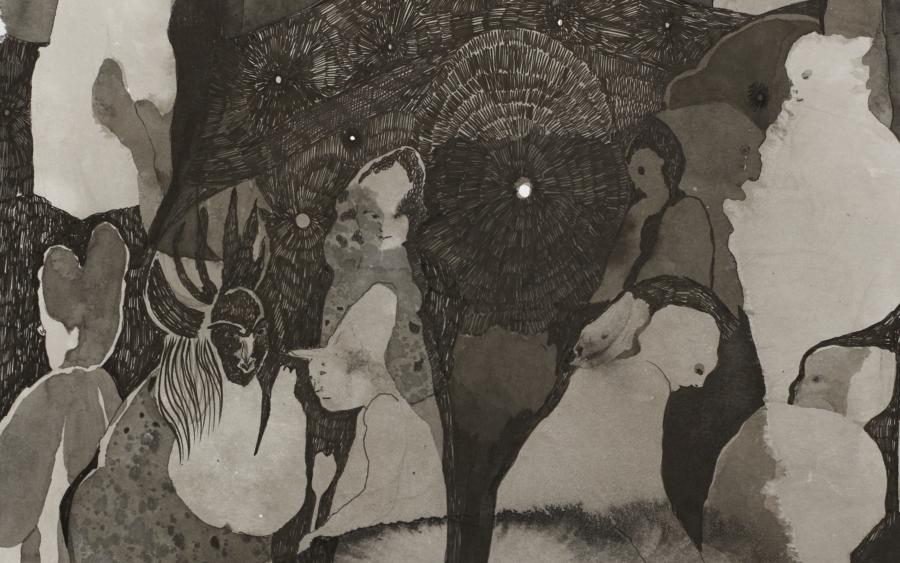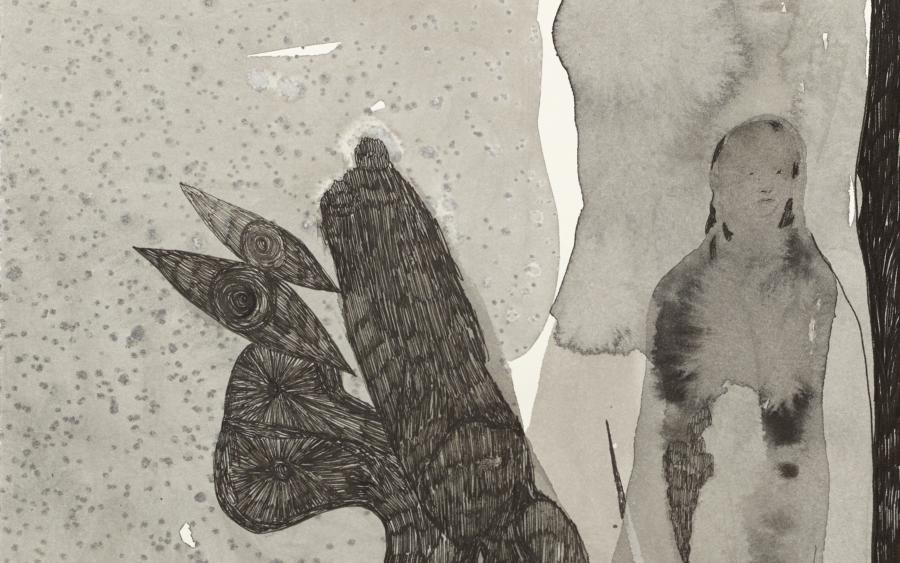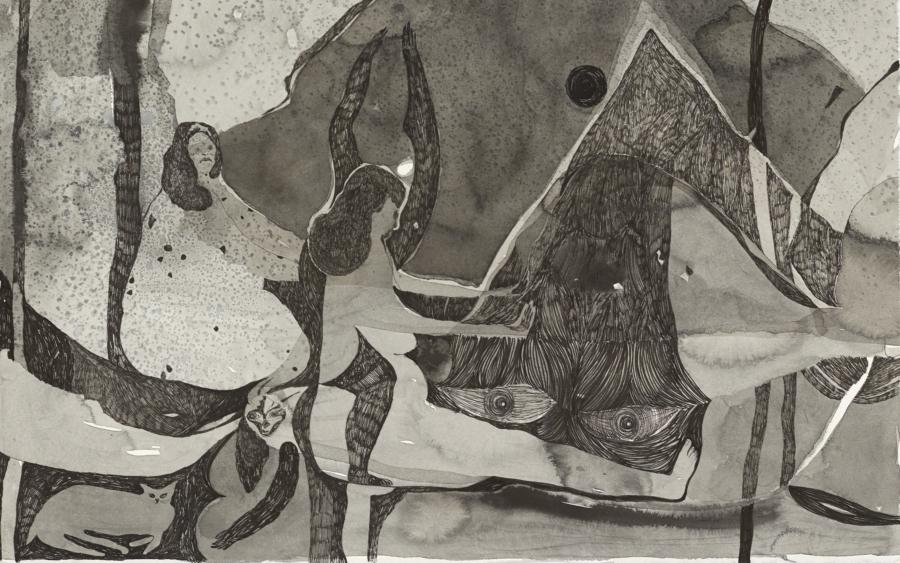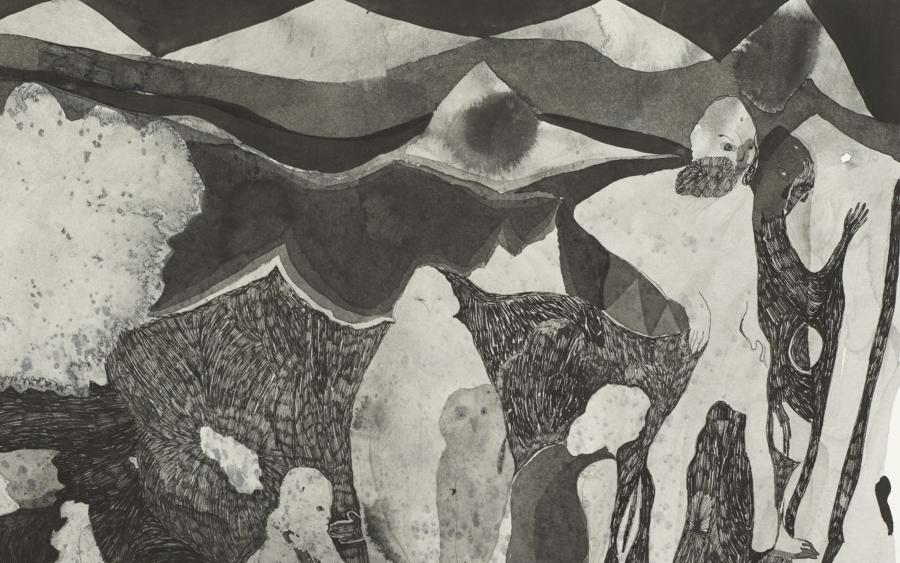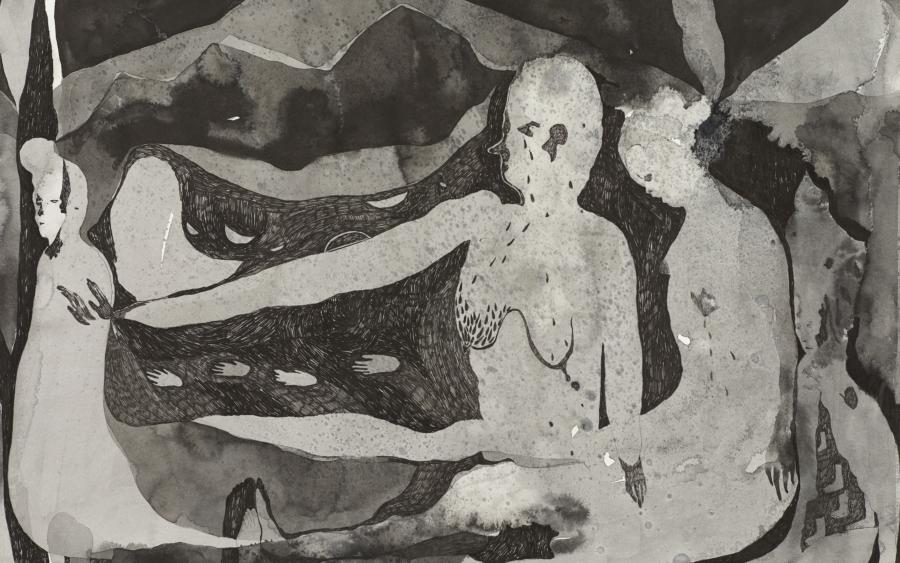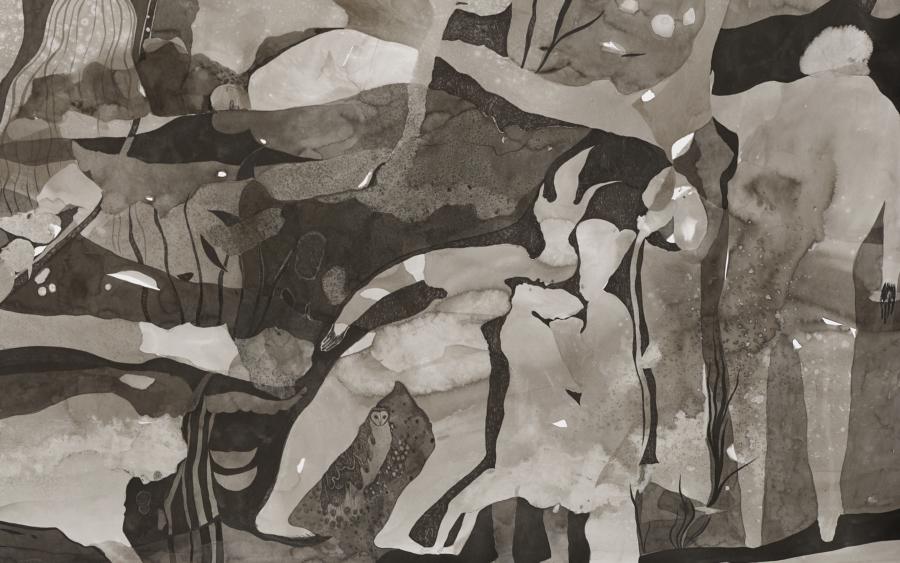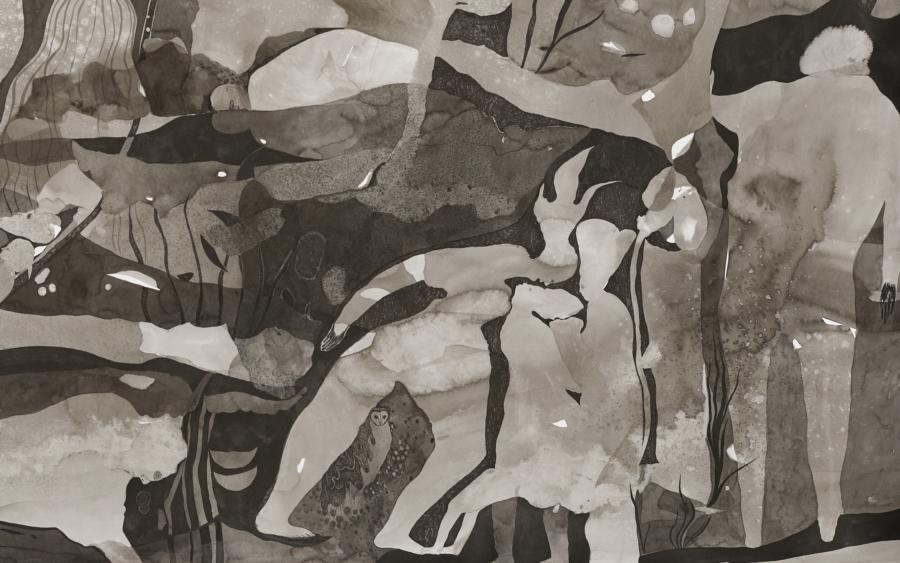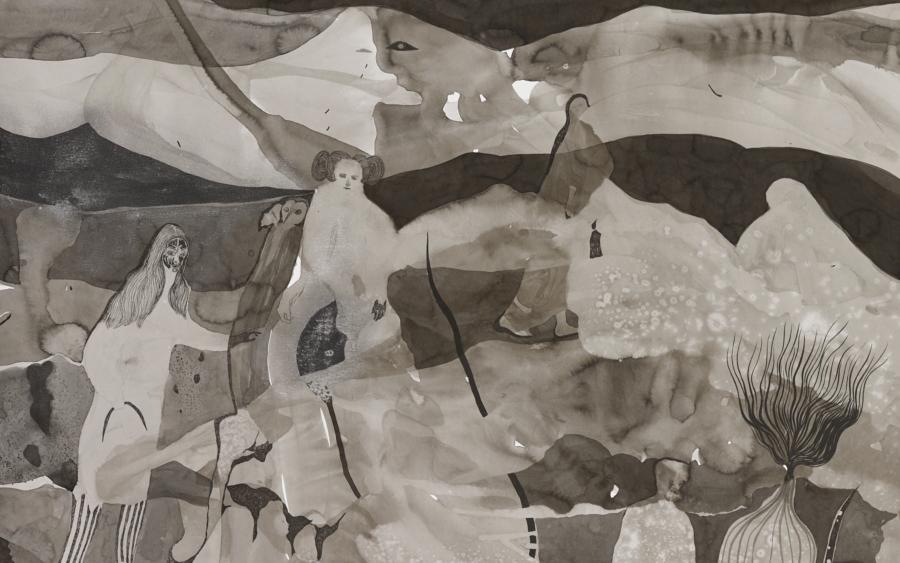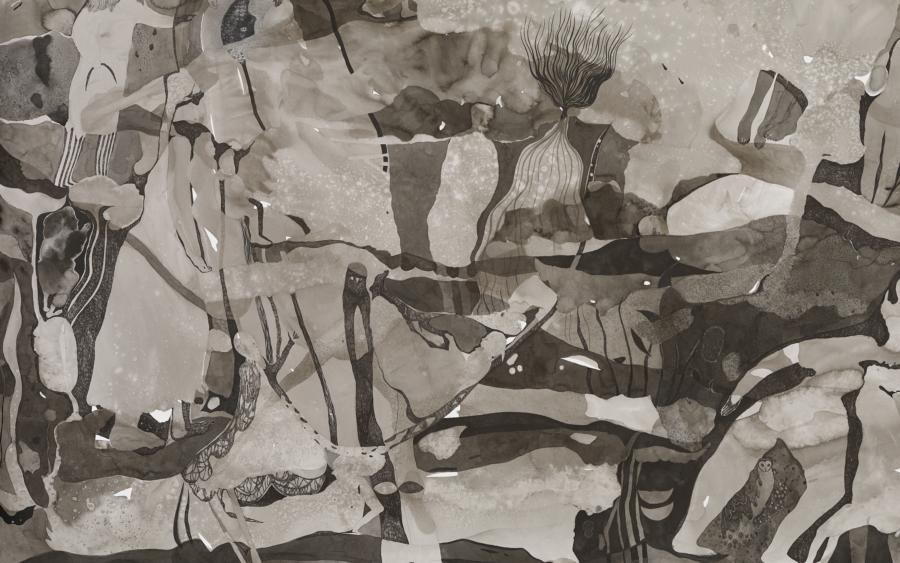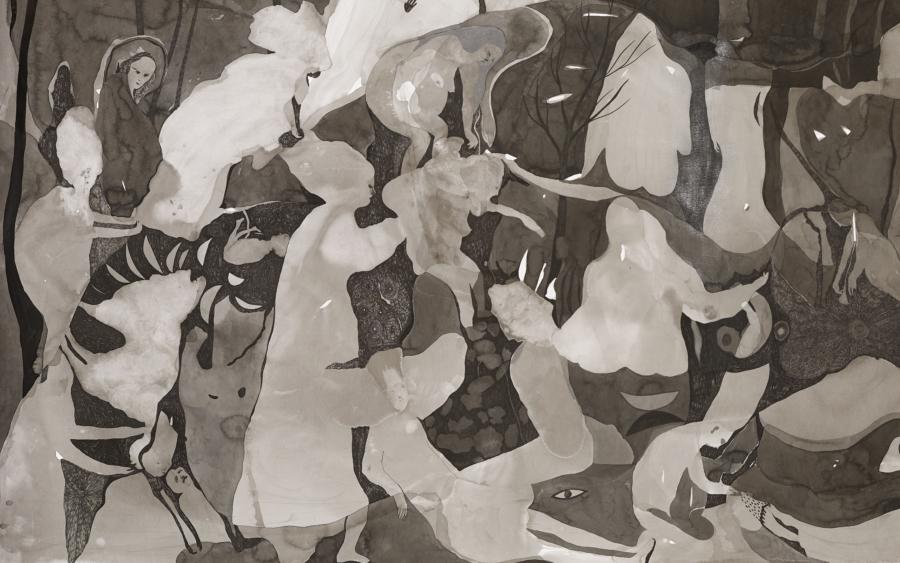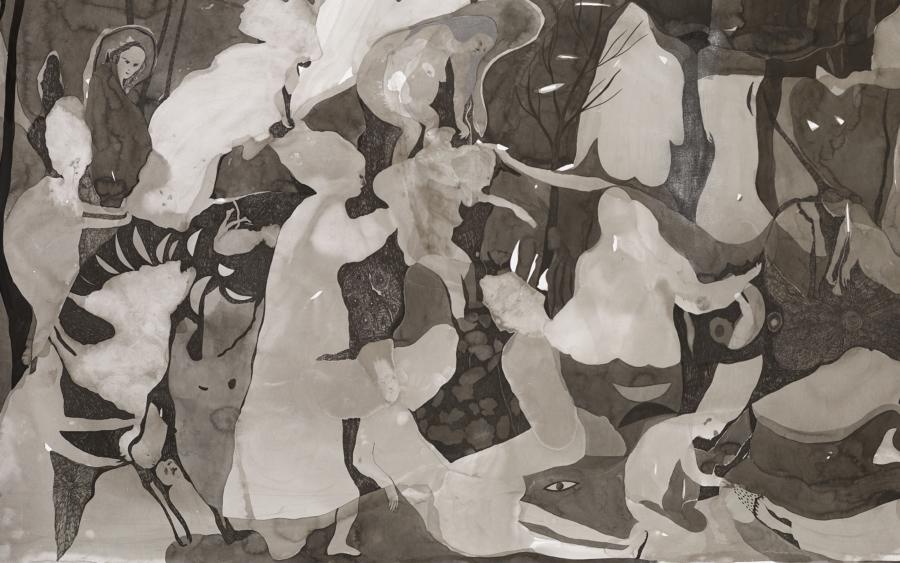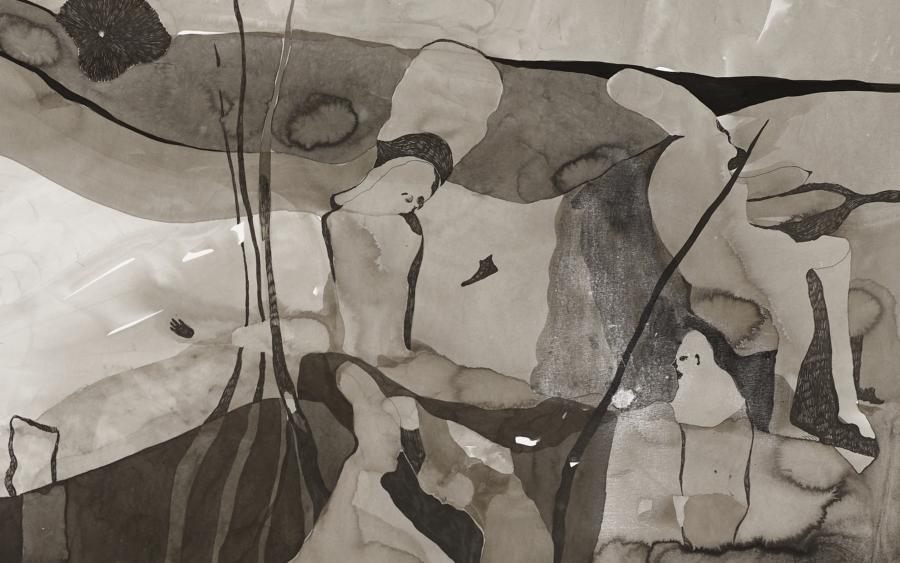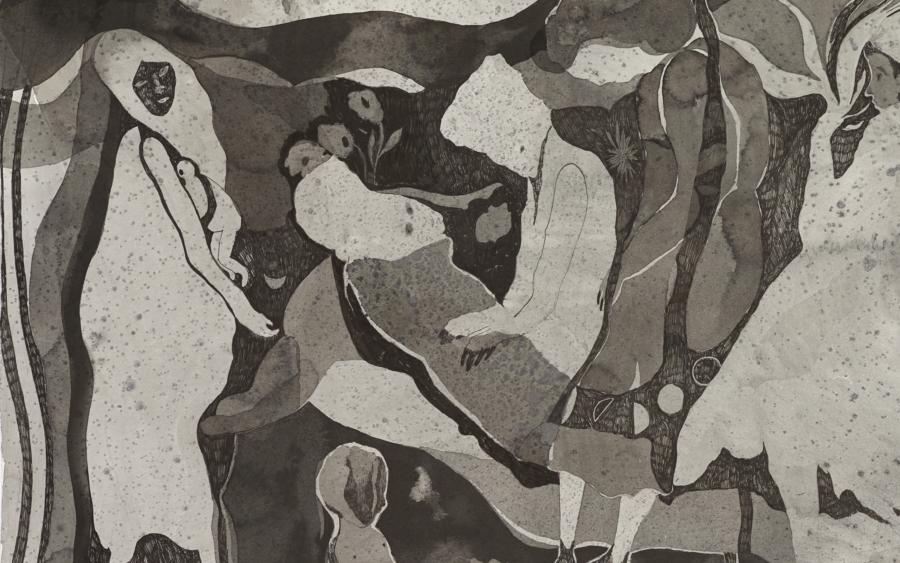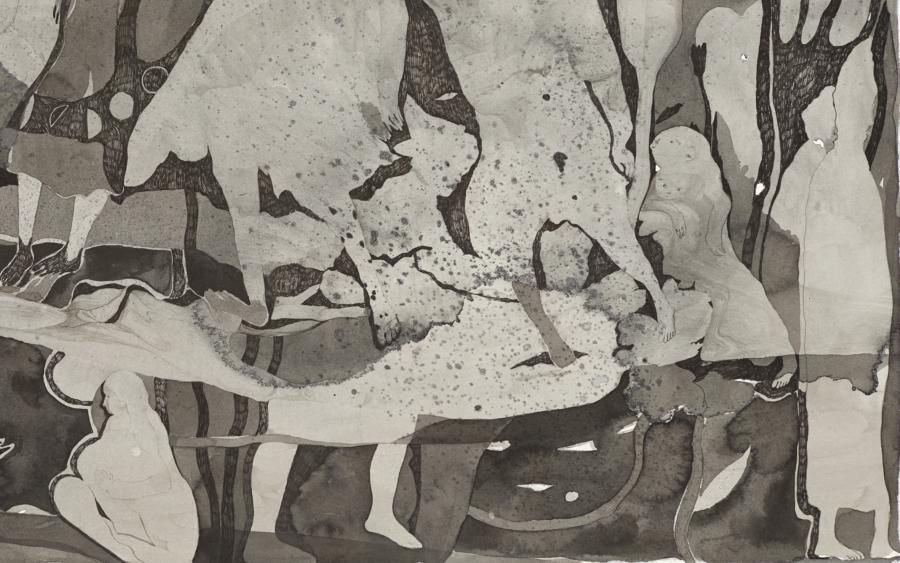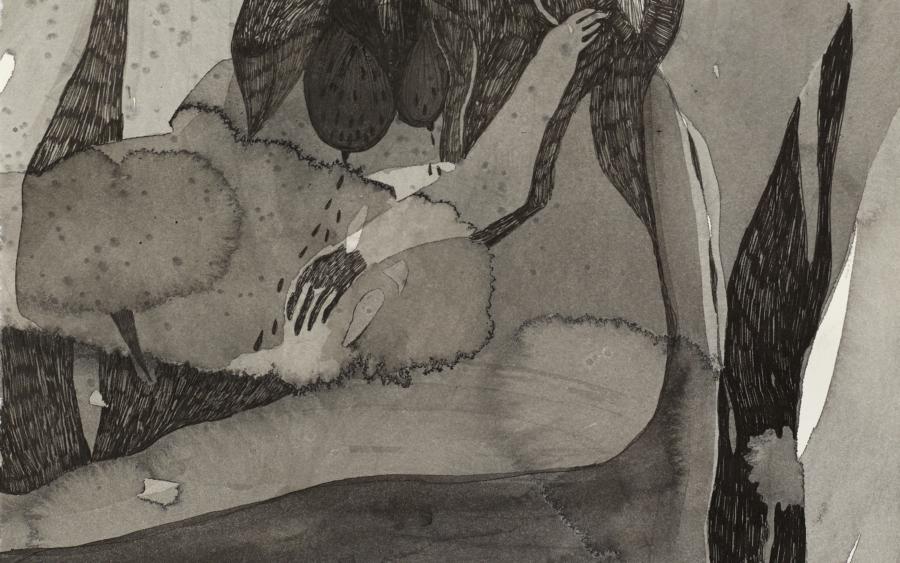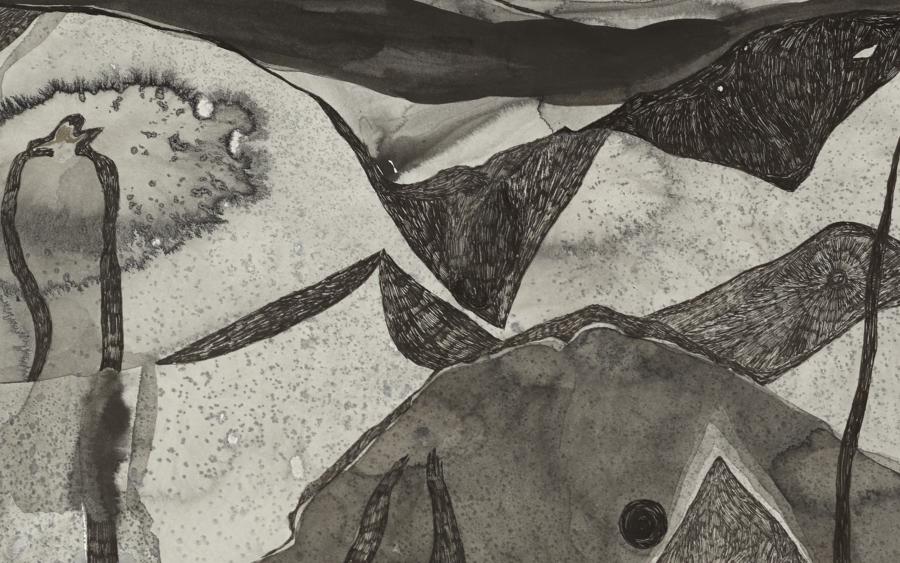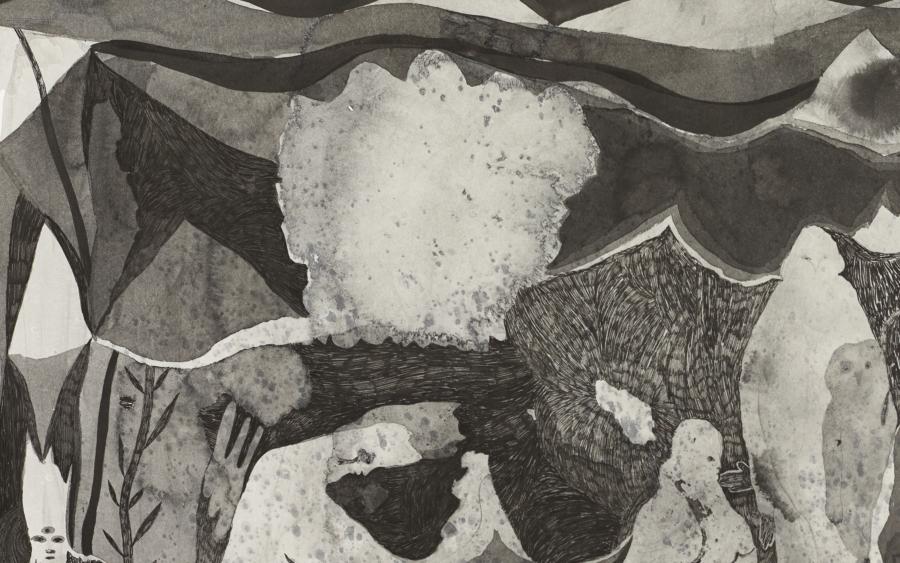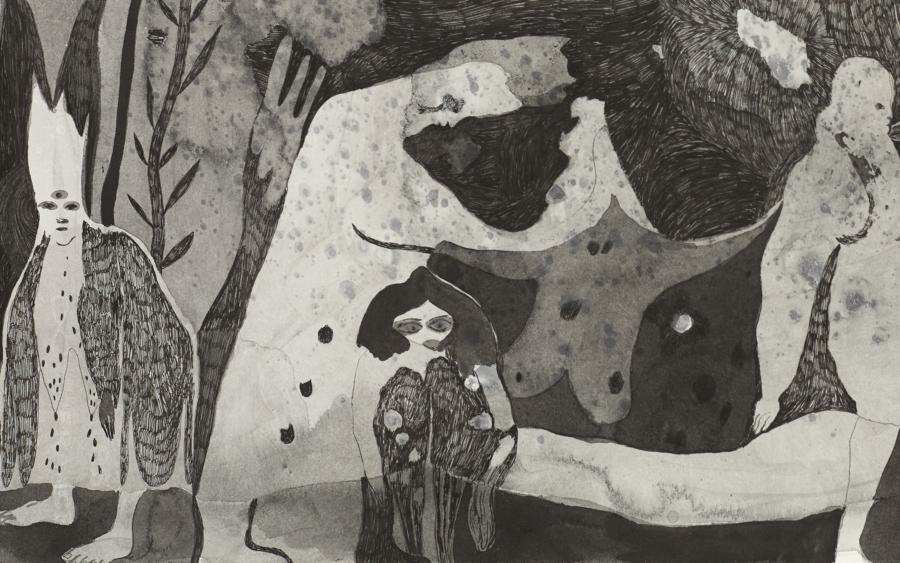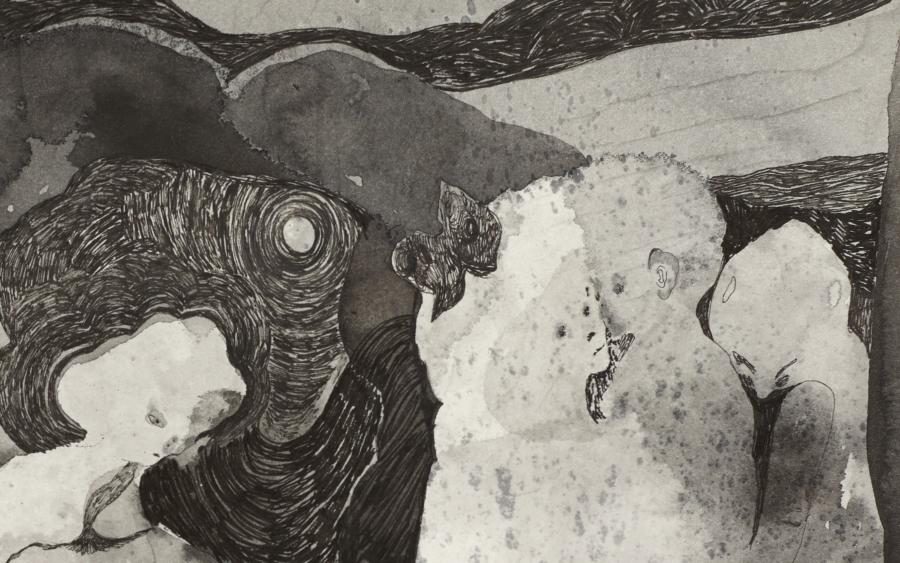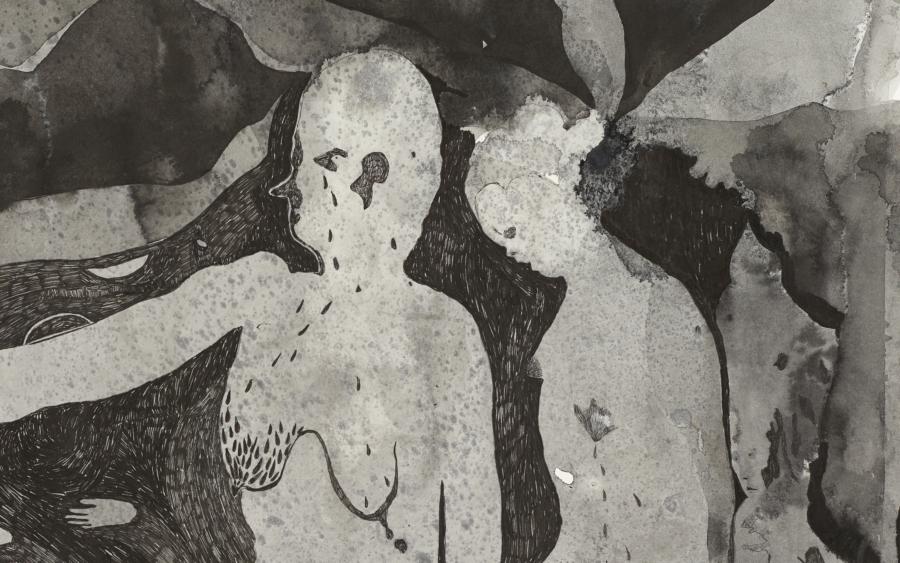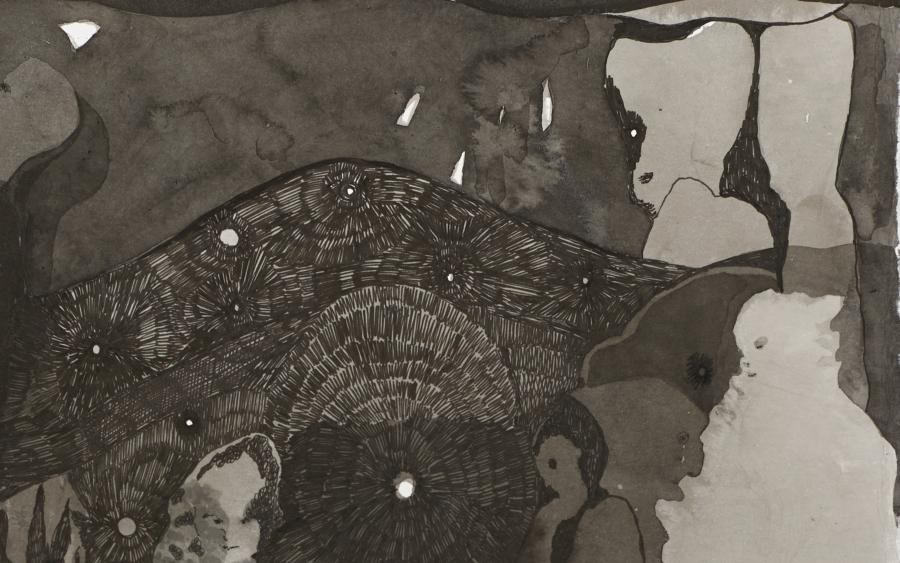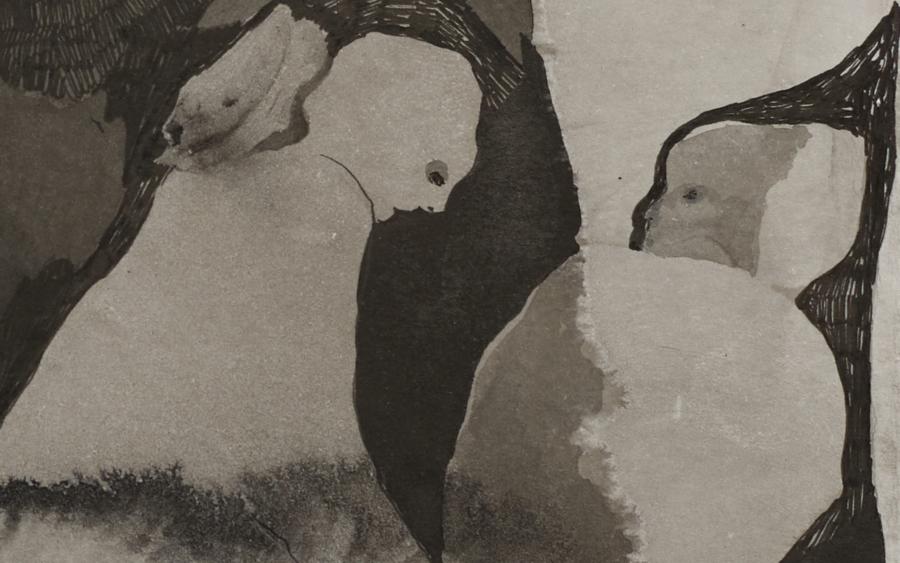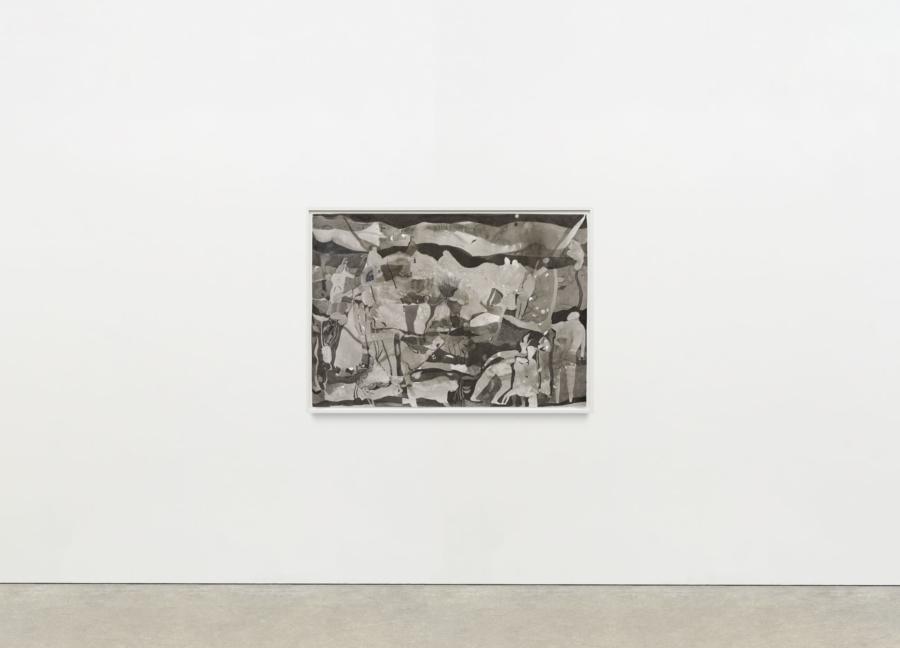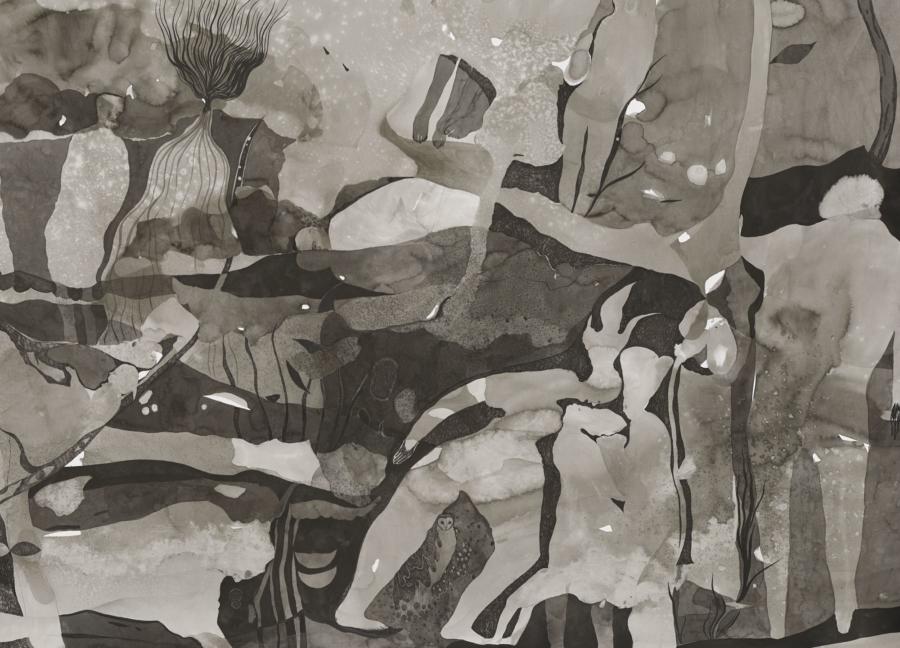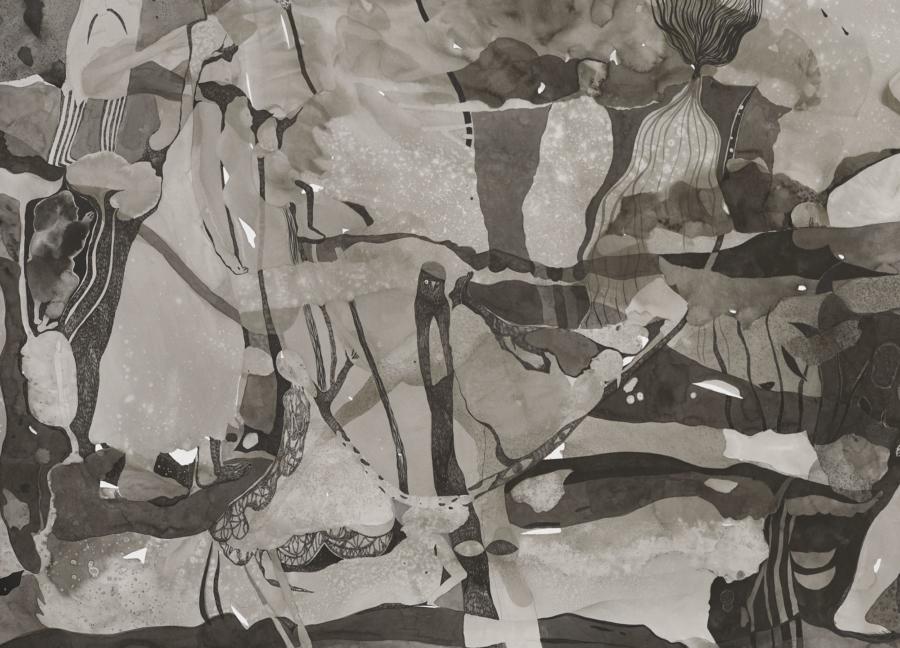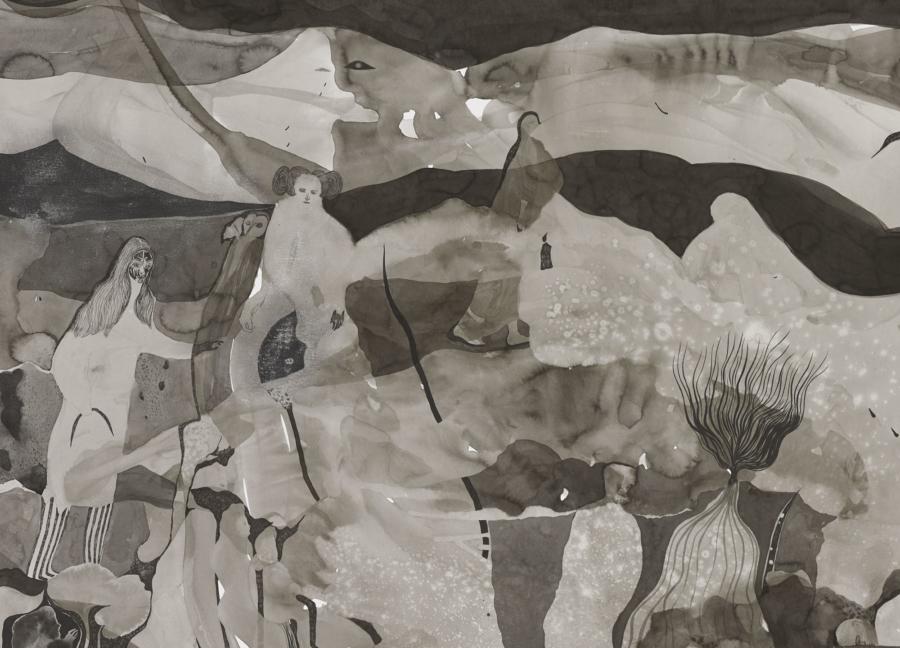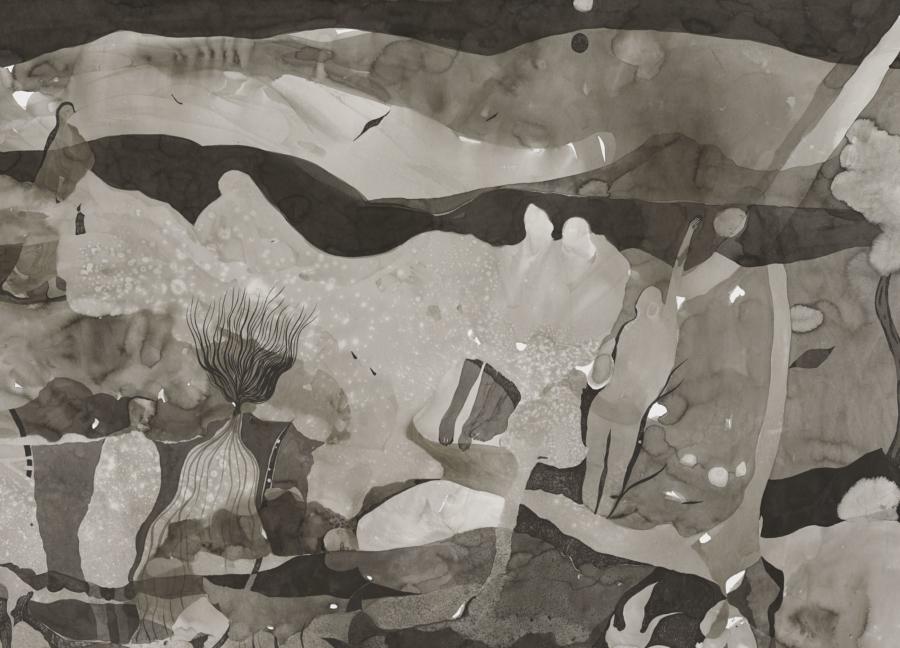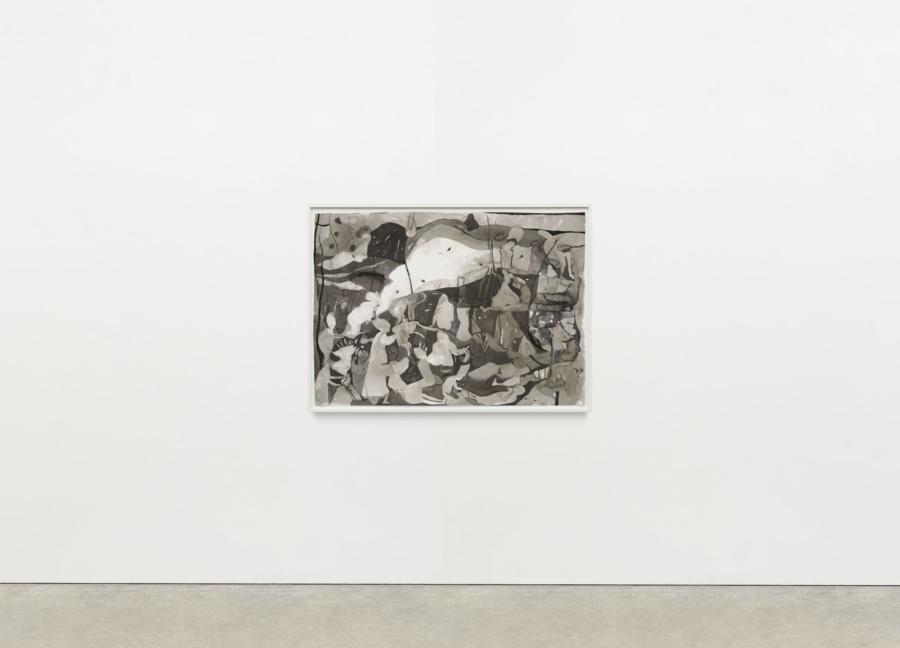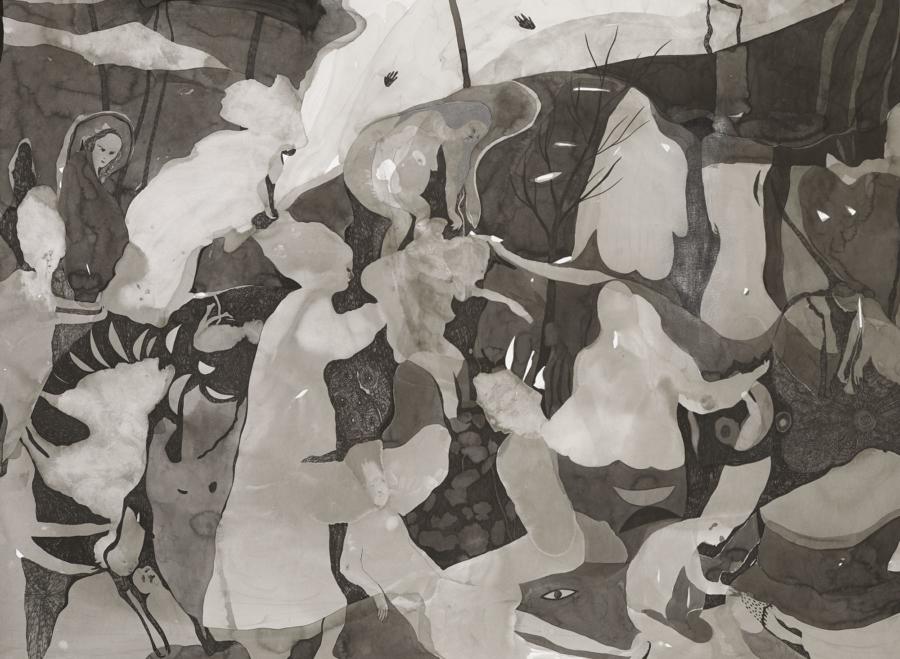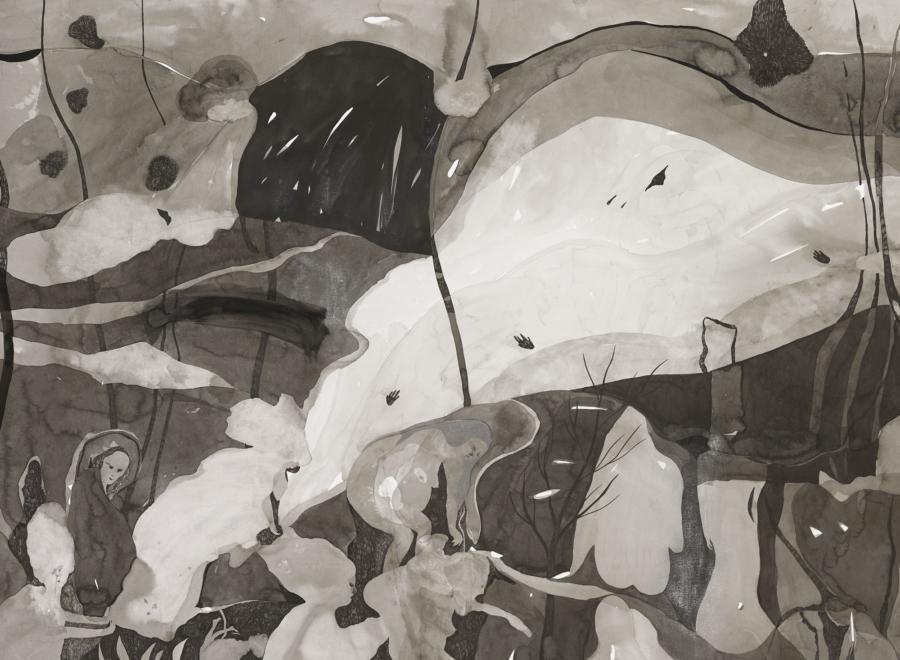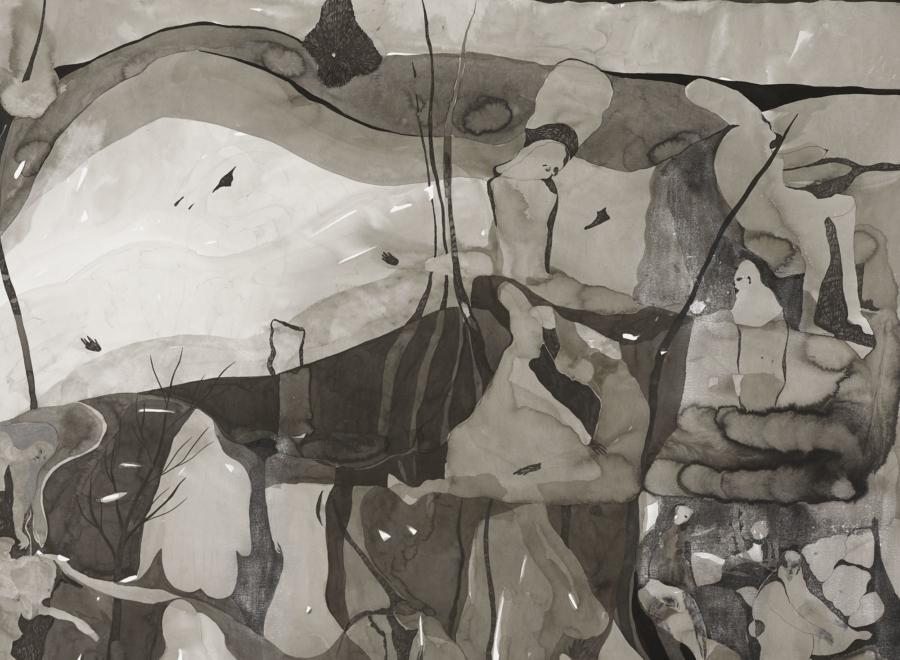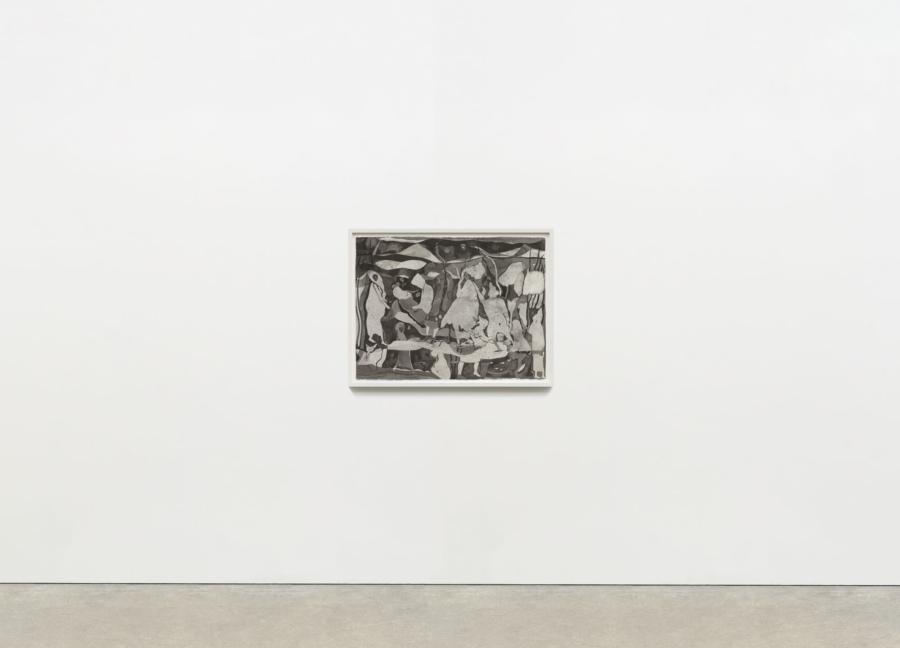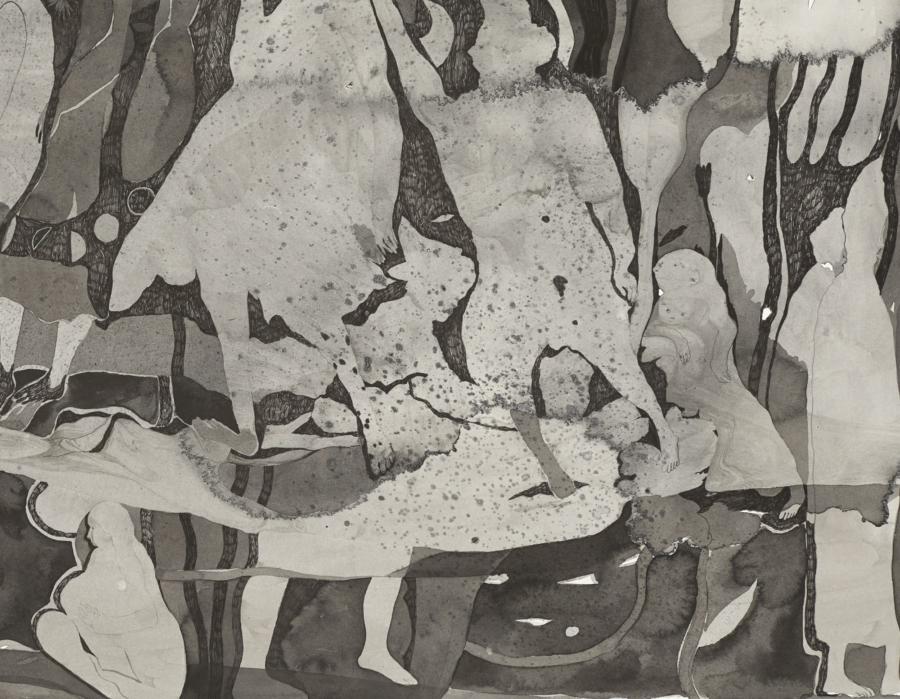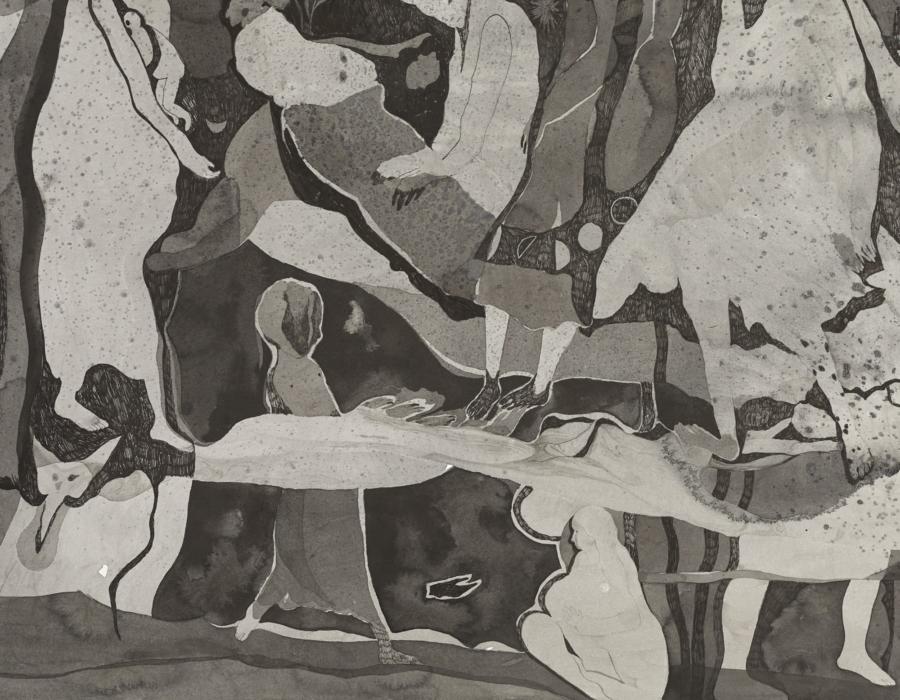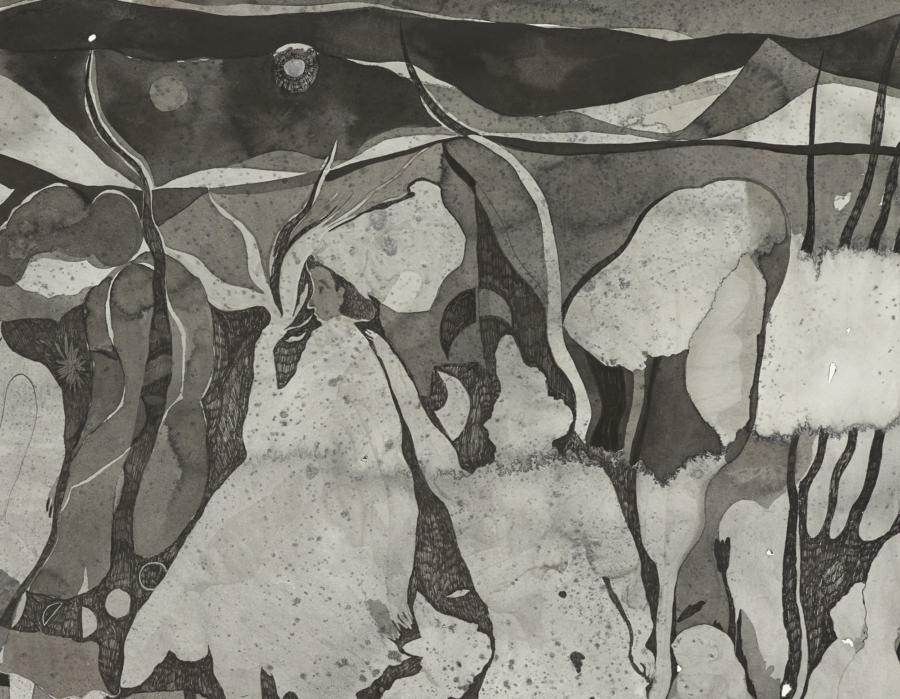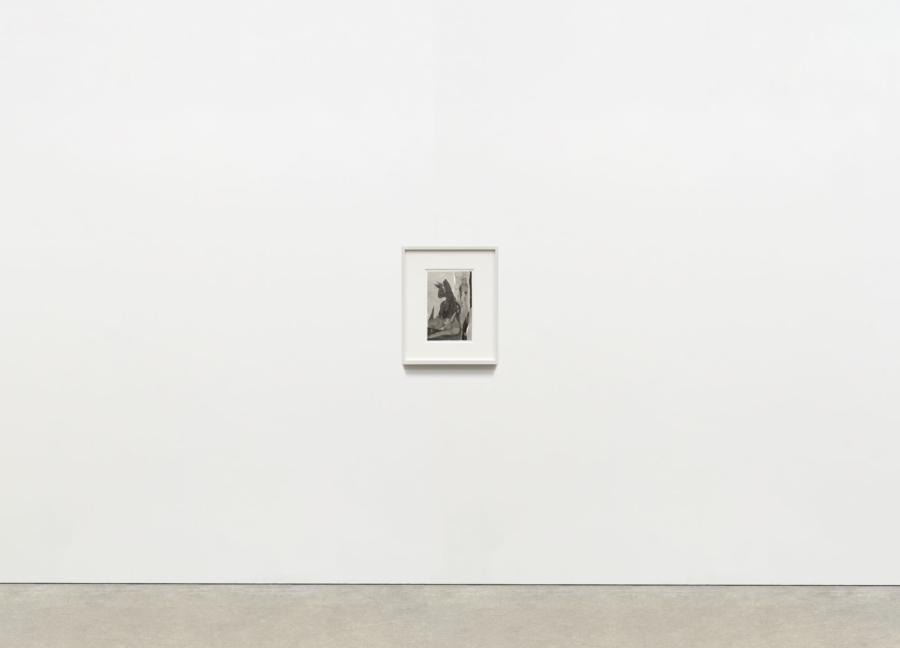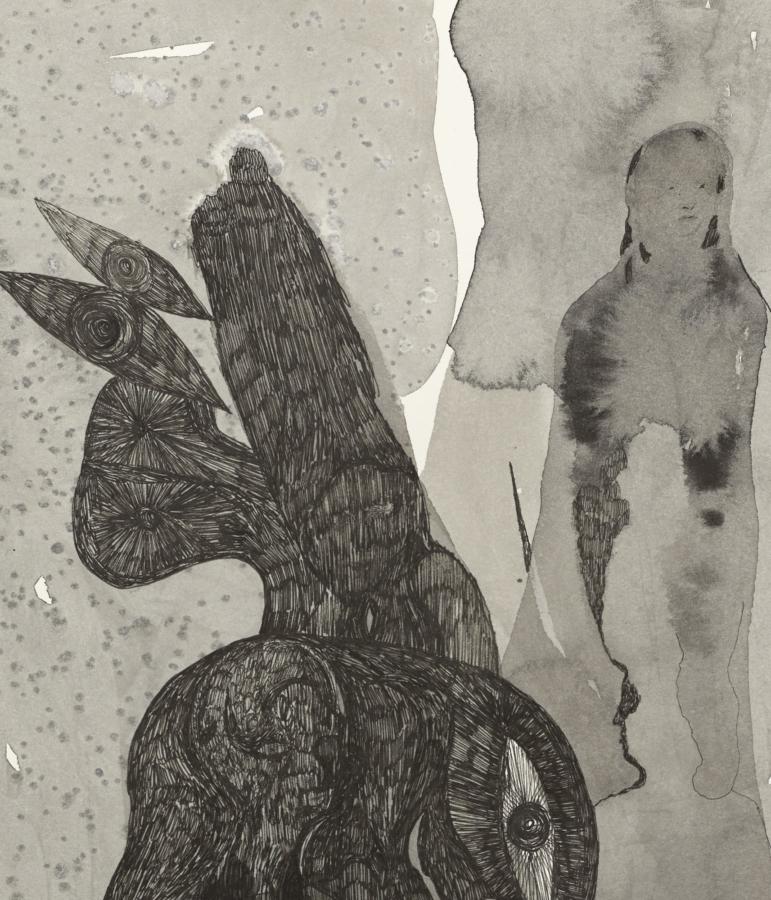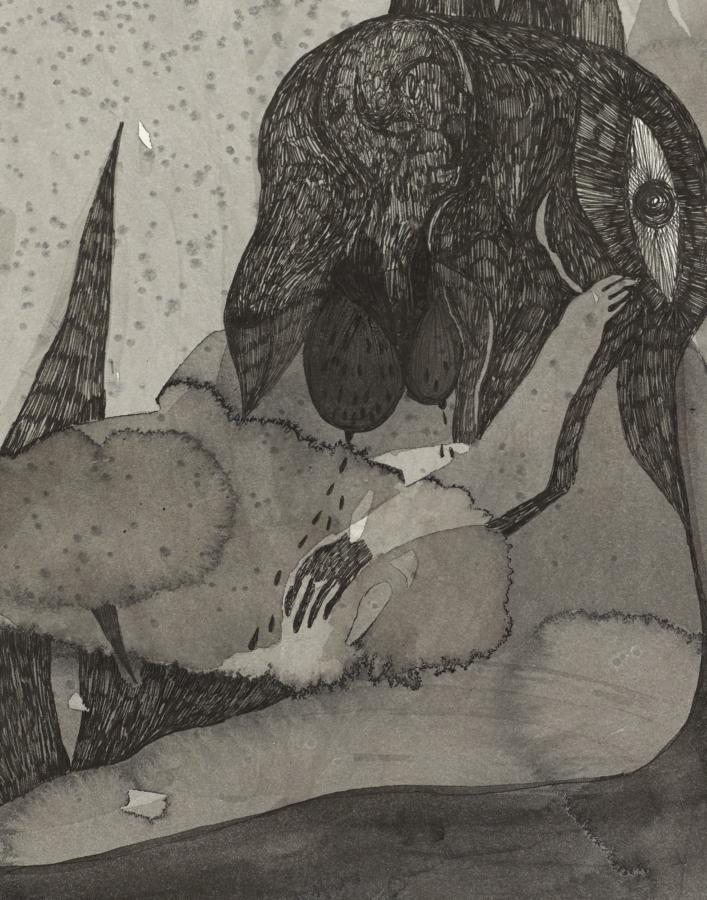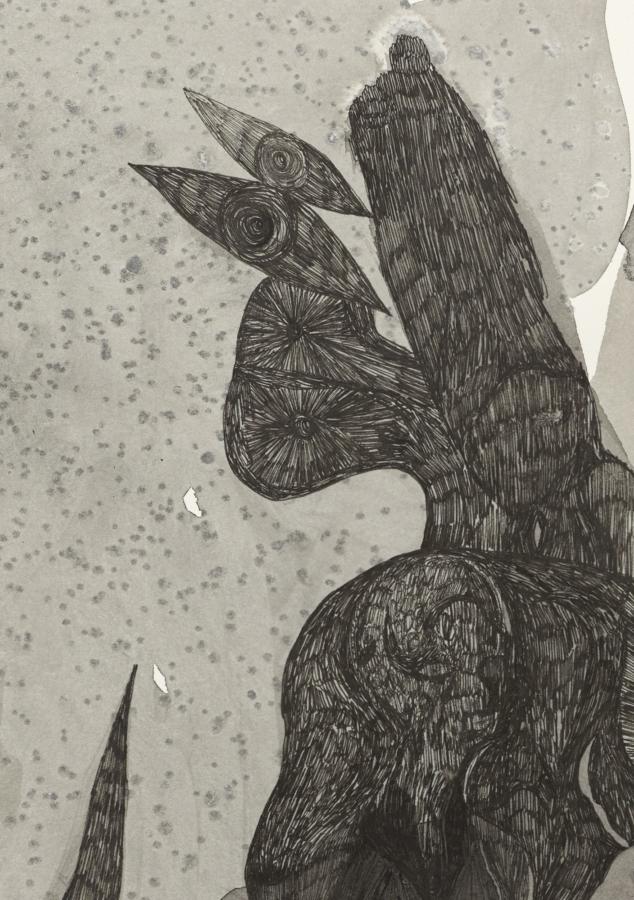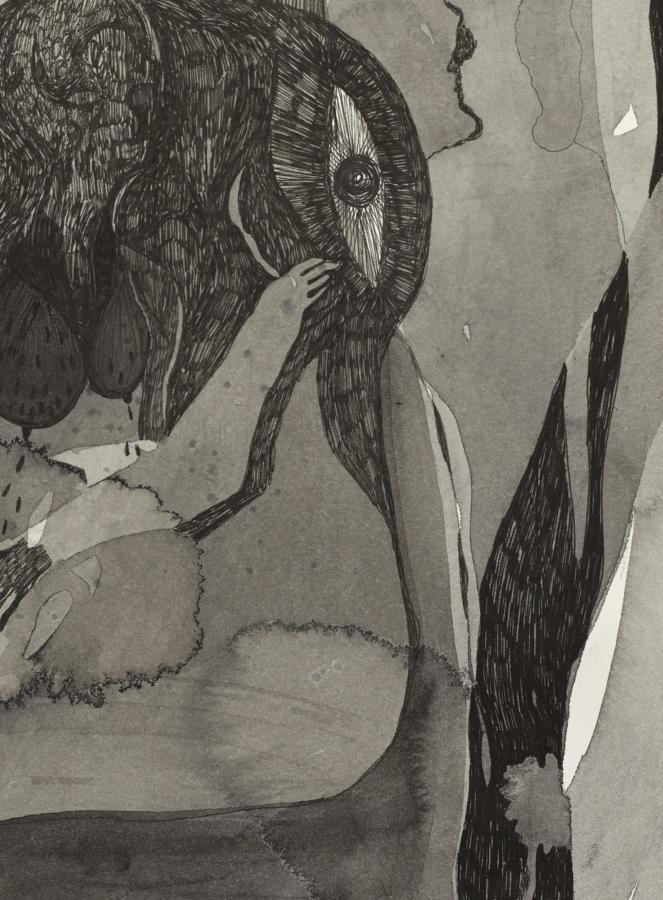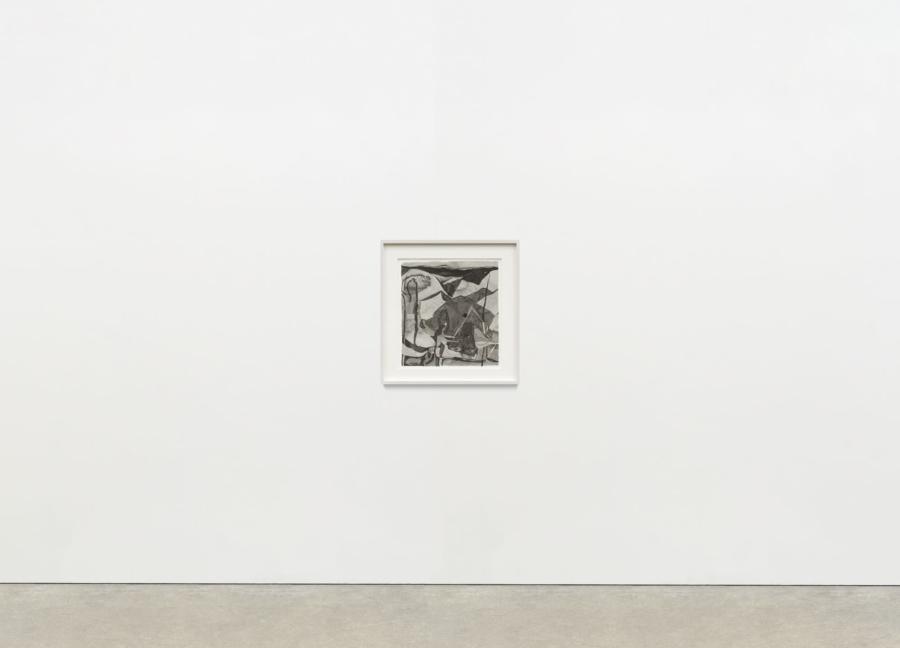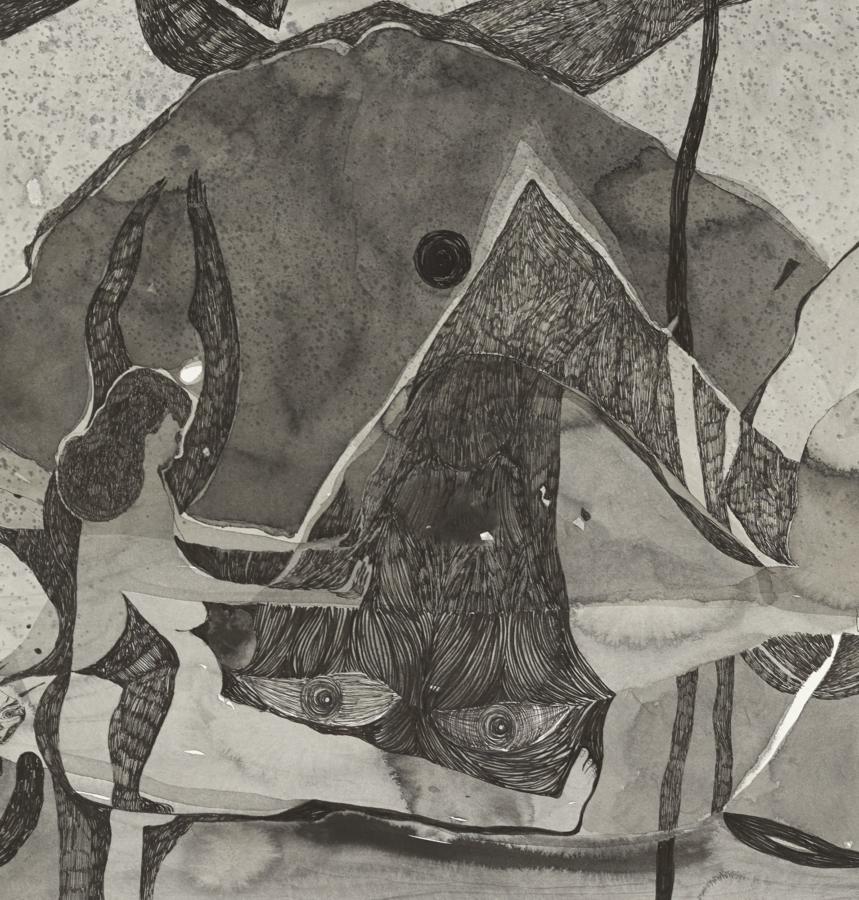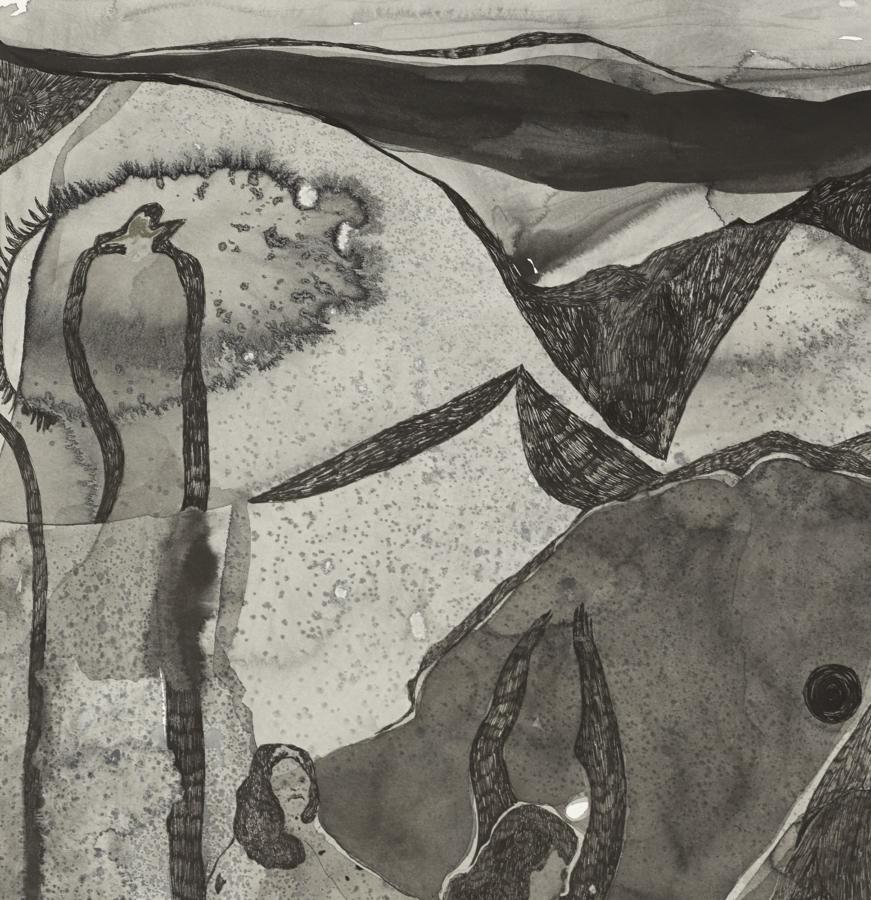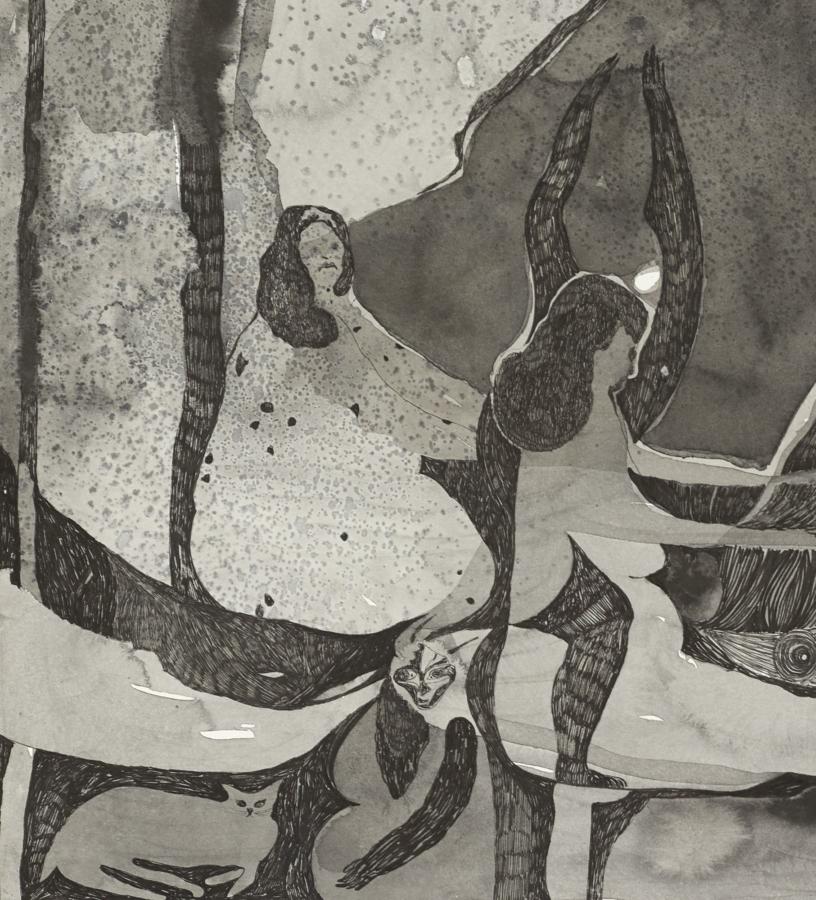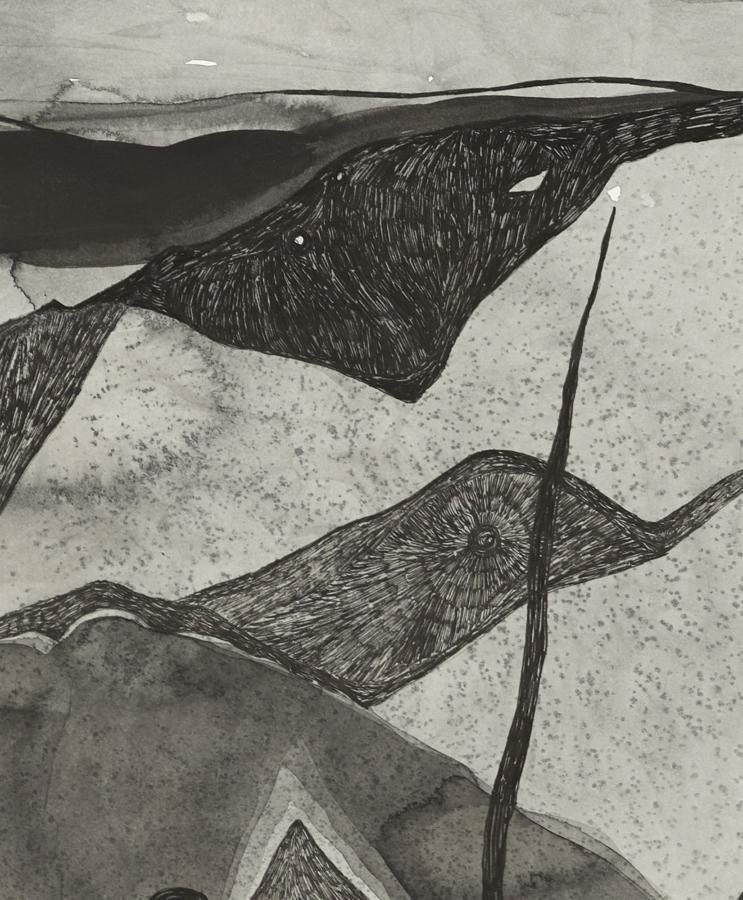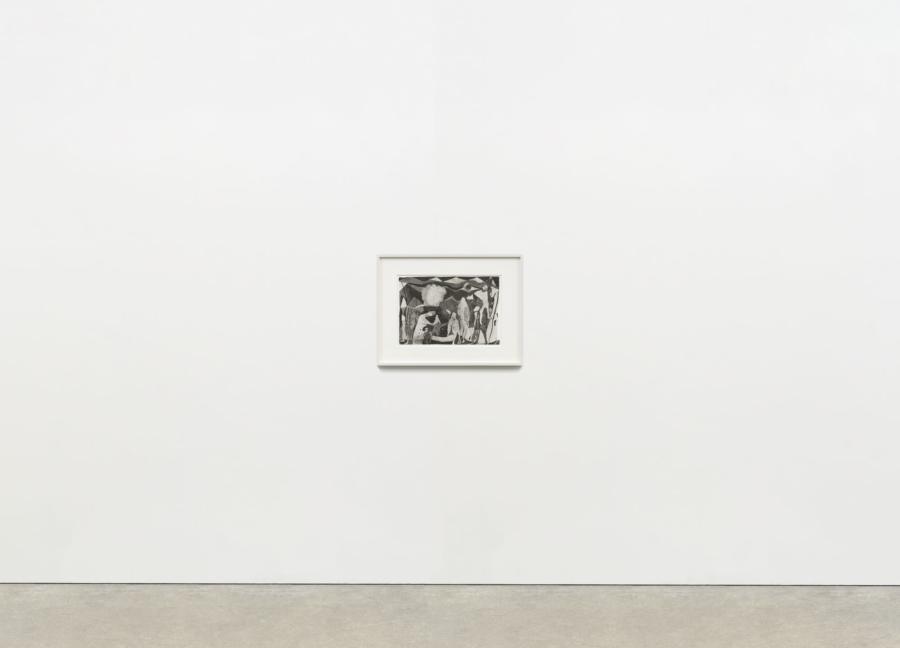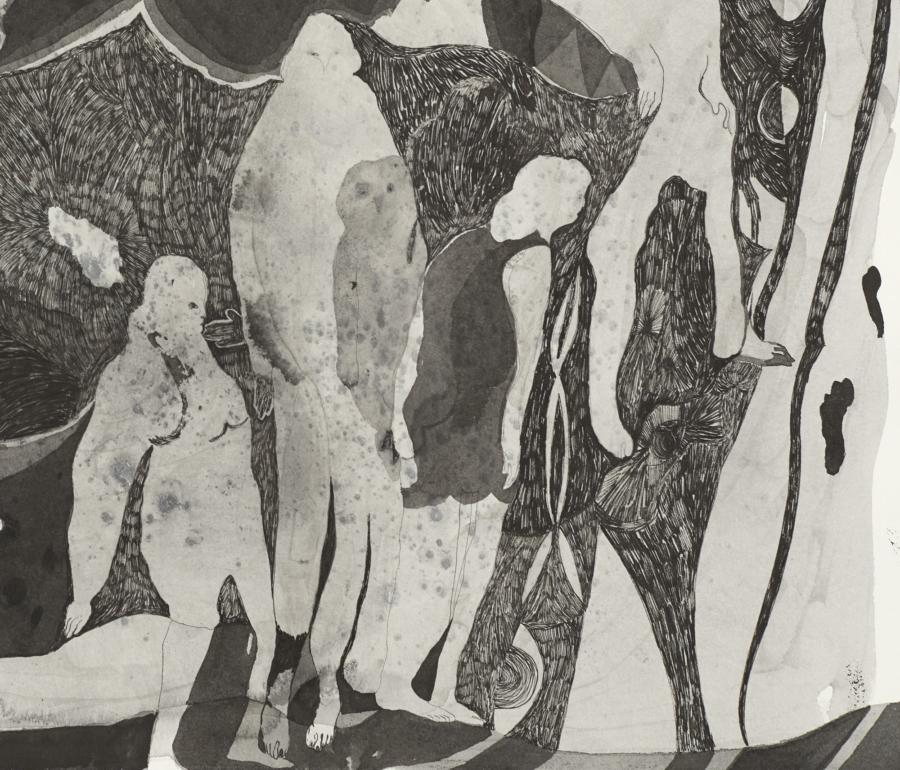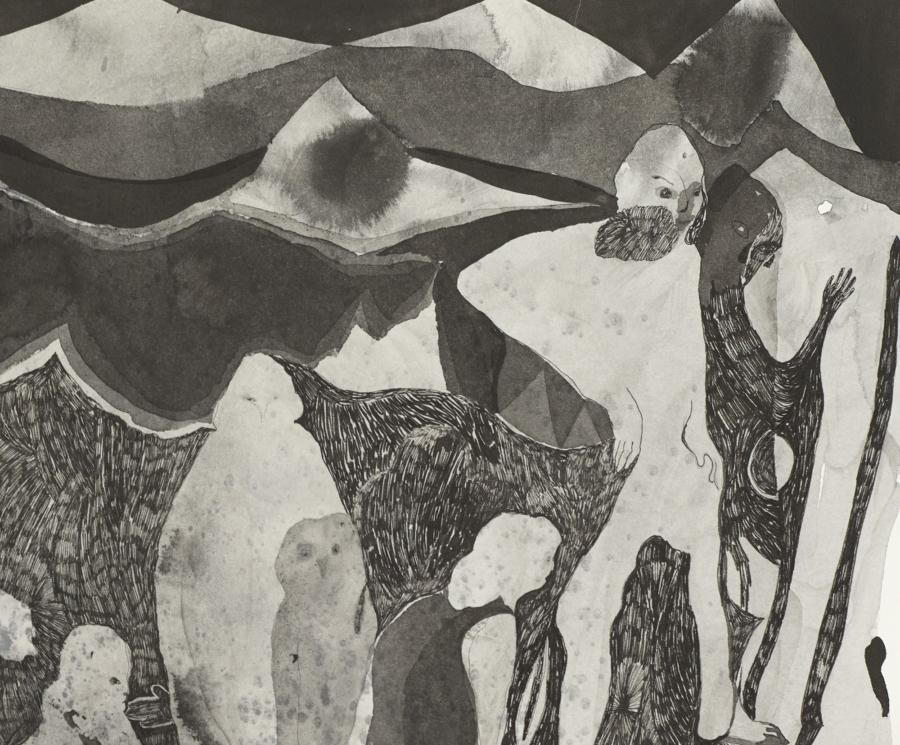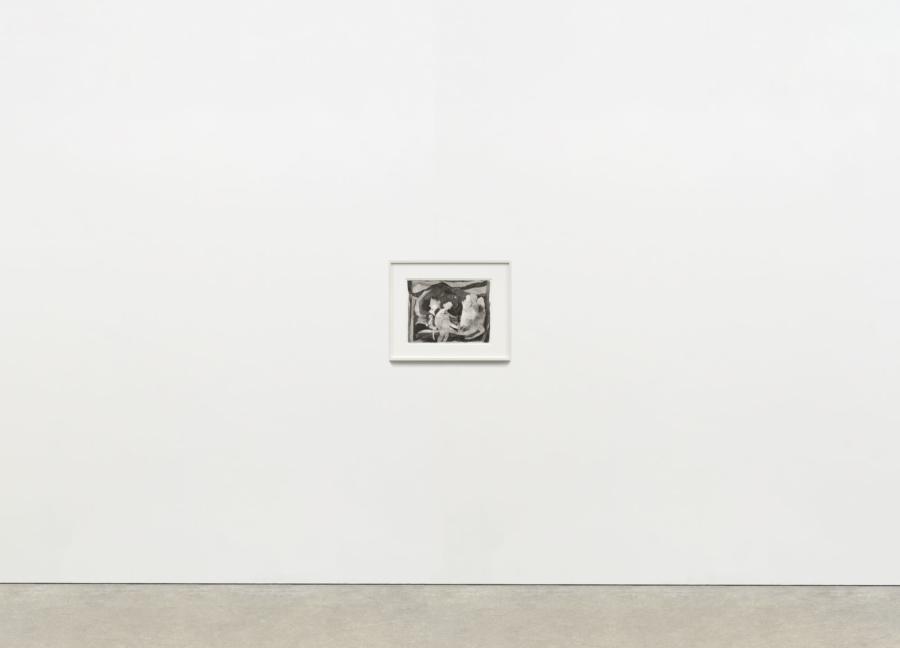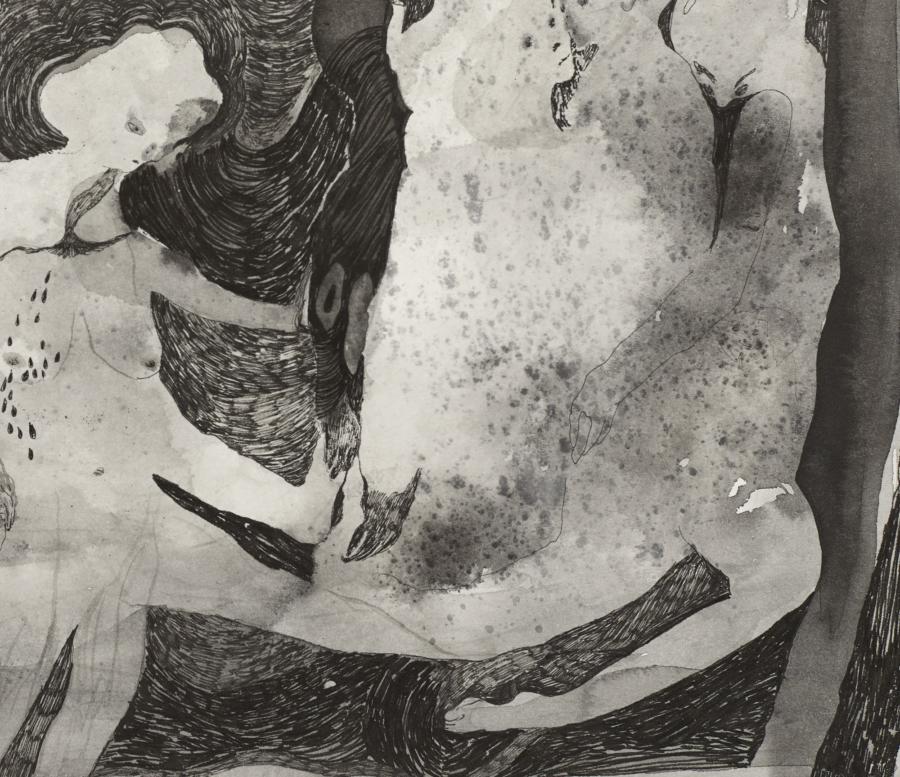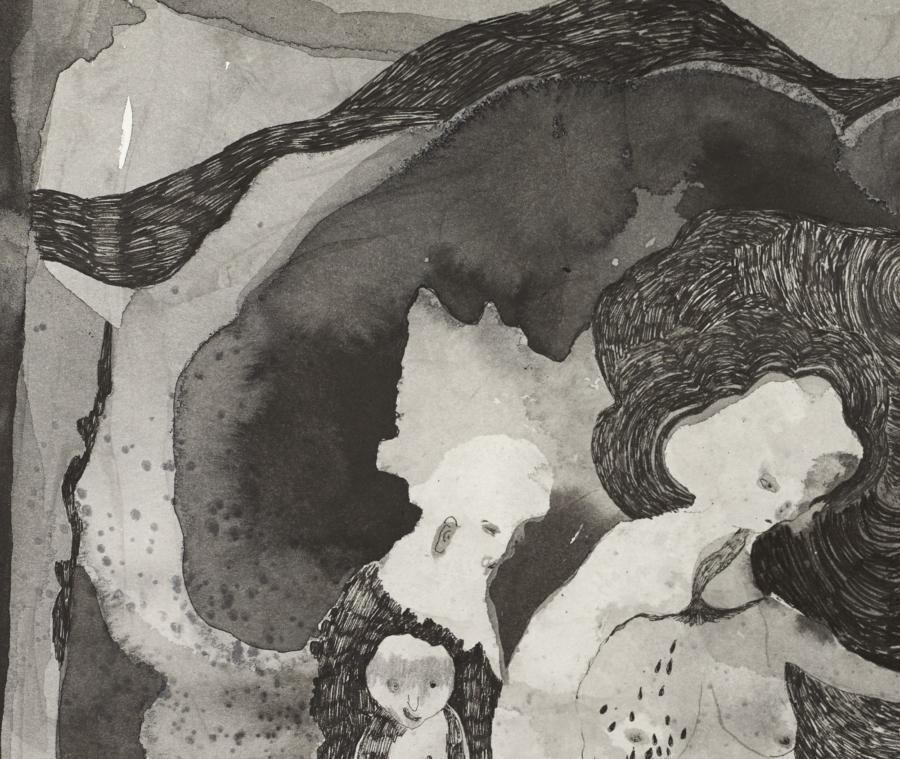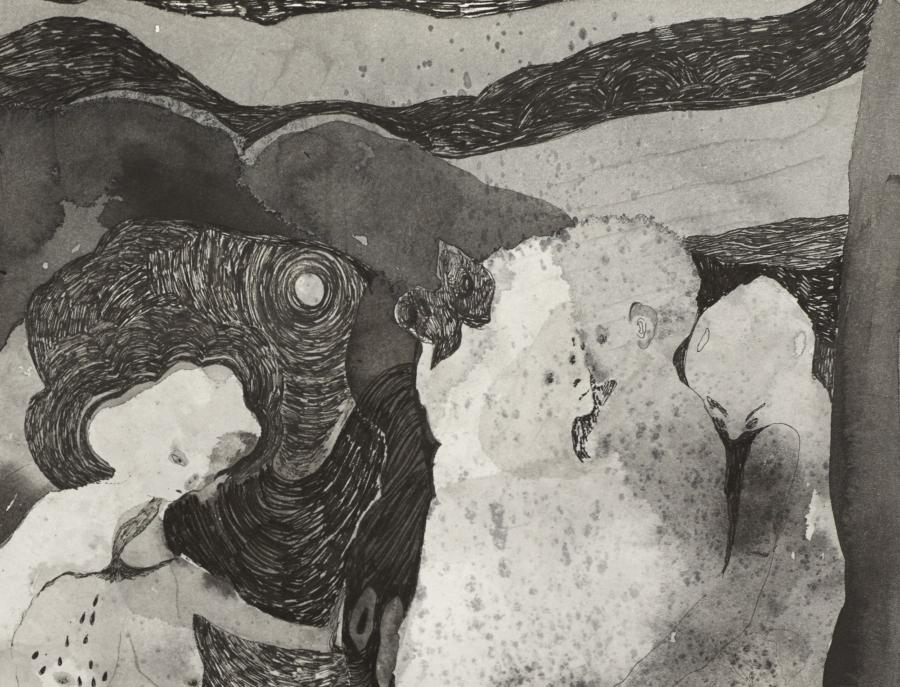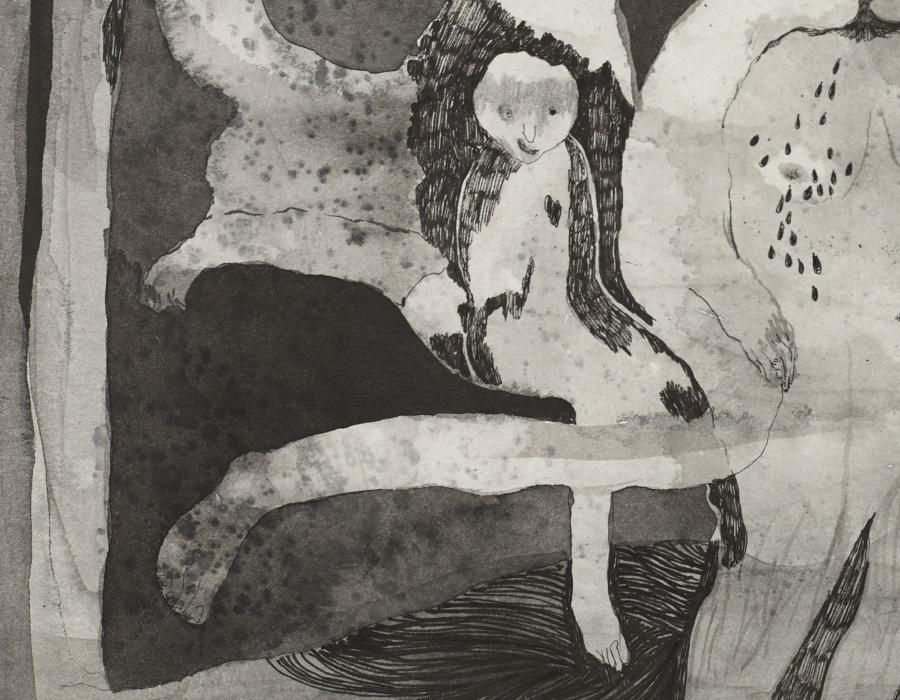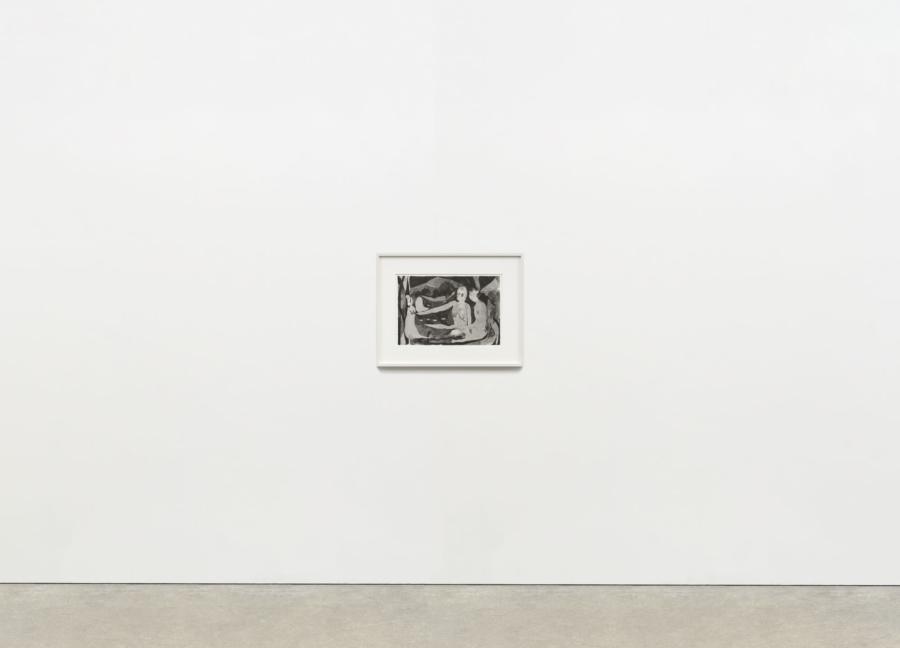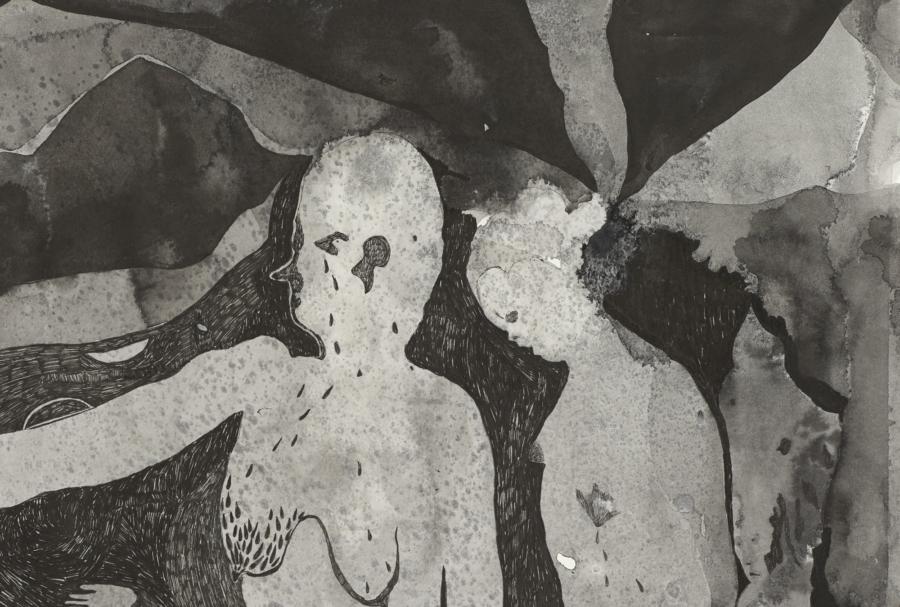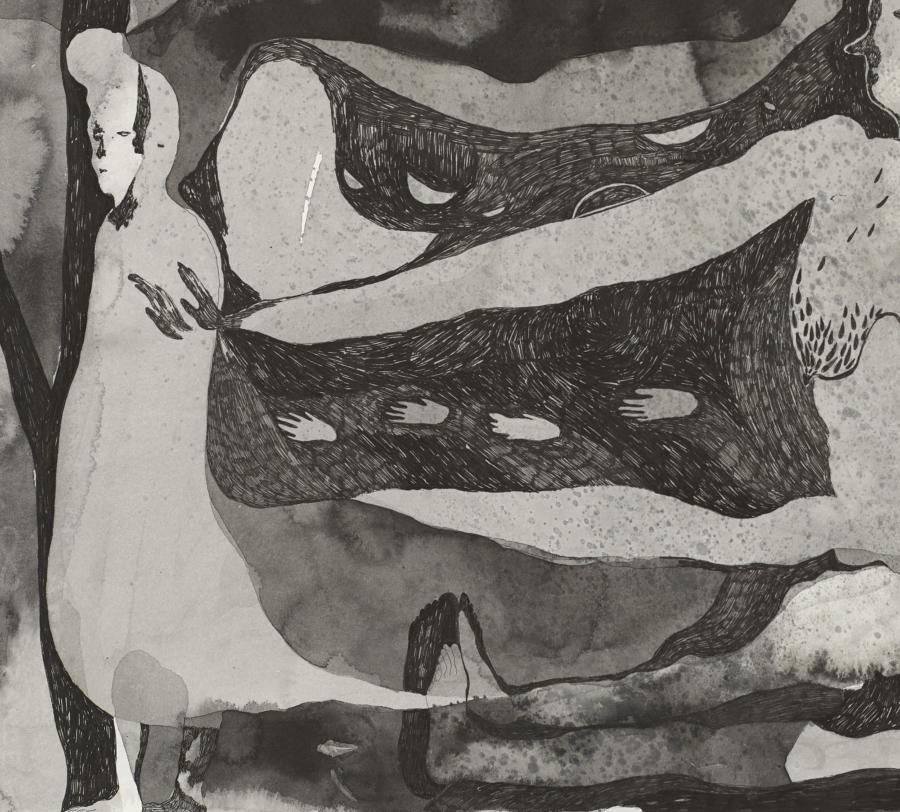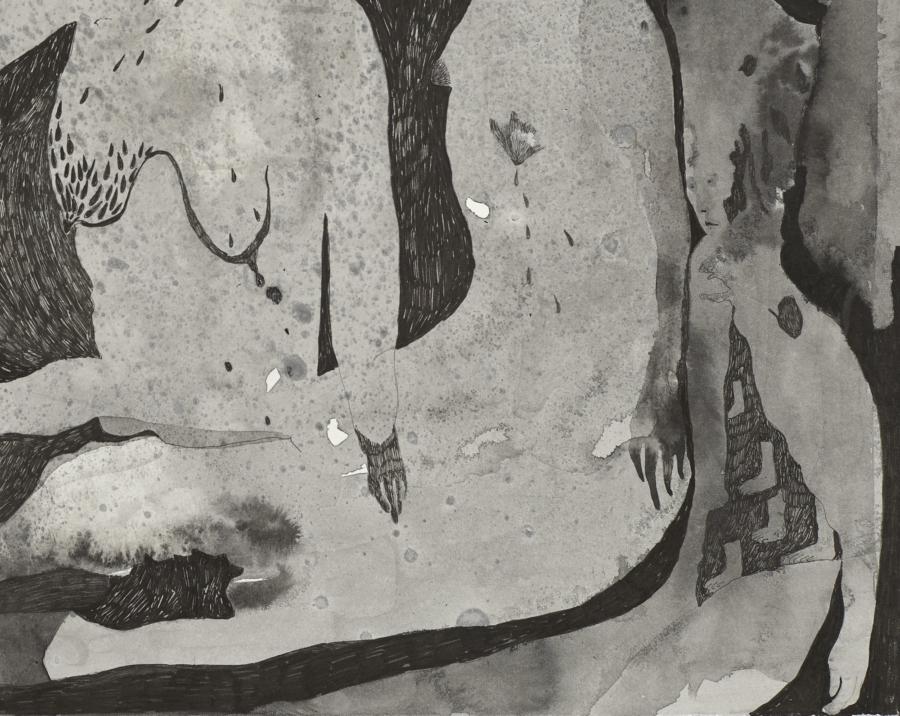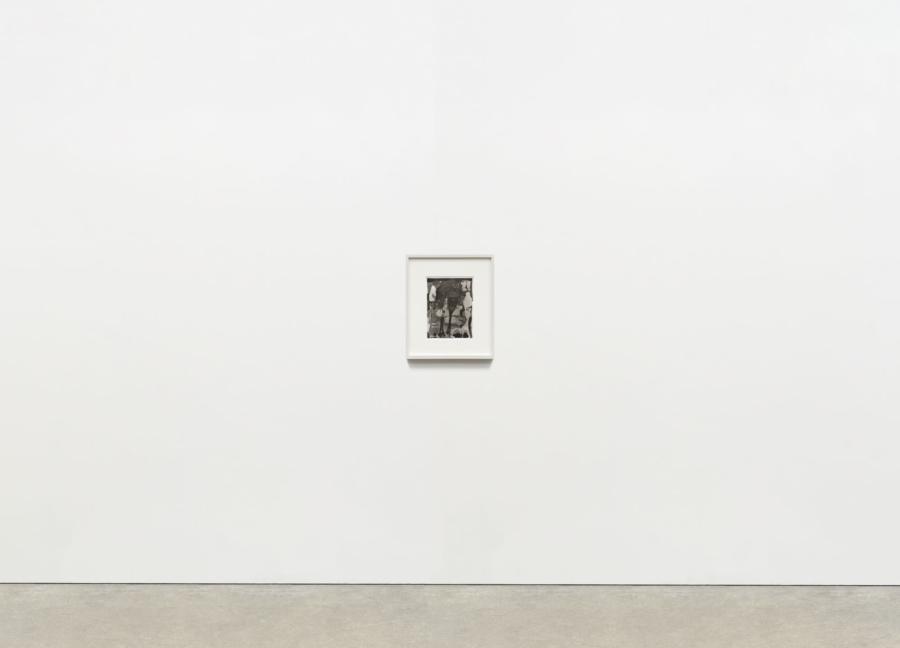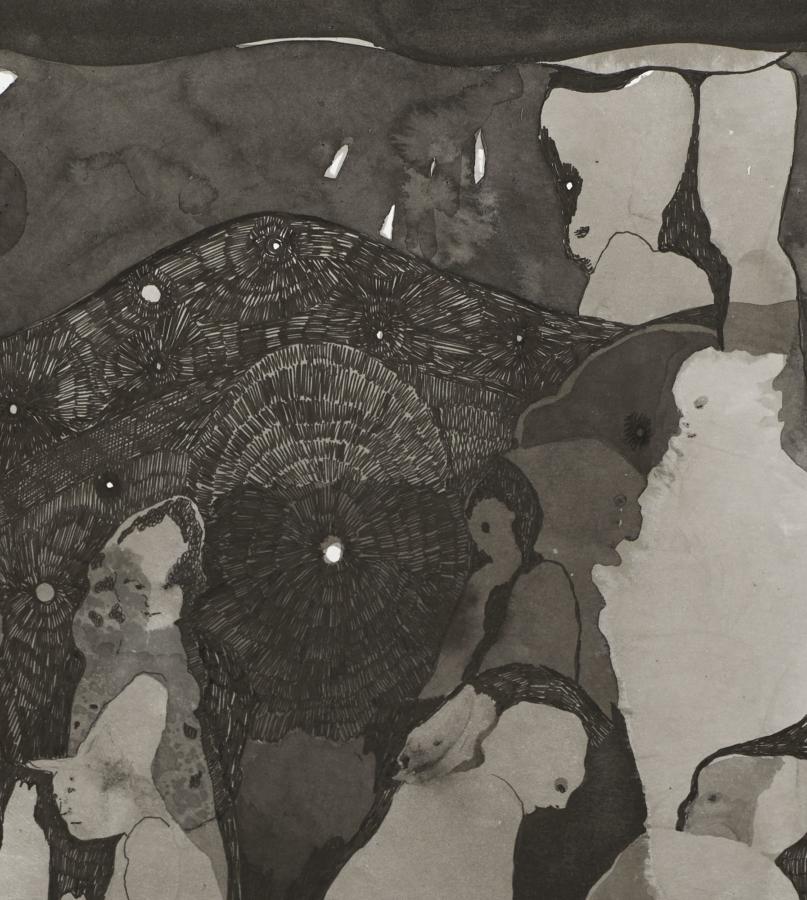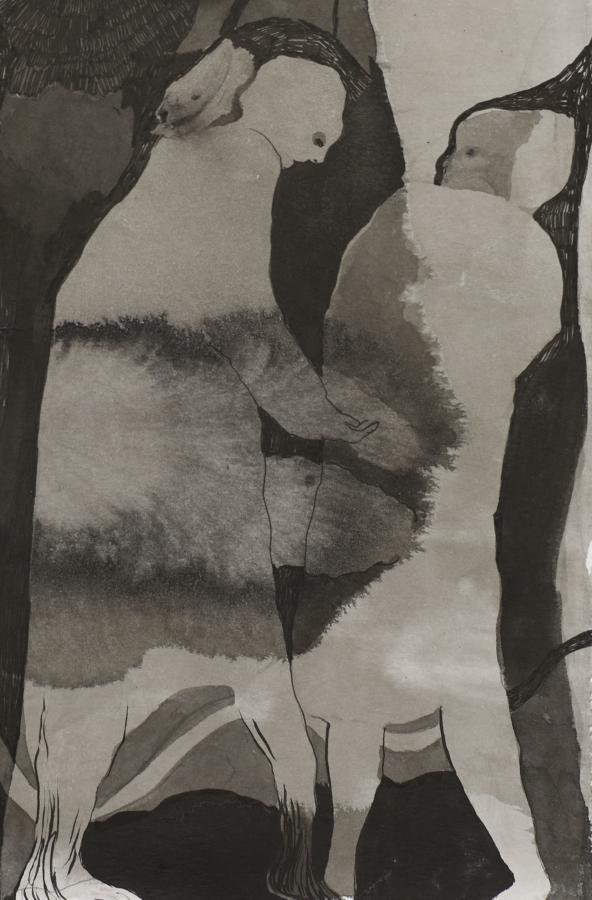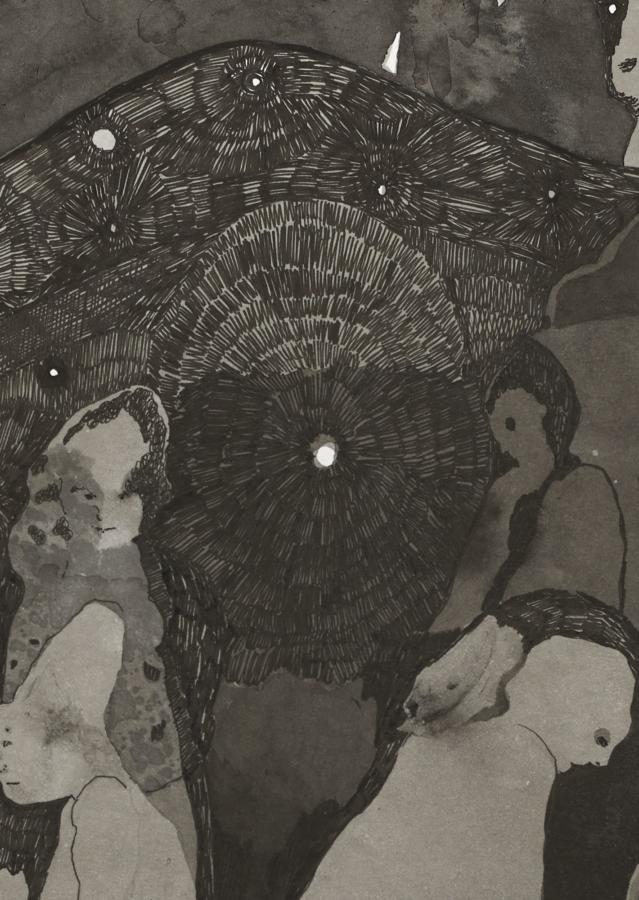Sleep Seekers 9, 2020 (detail)
Sleep Seekers 3, 2020 (detail)
Sleep Seekers 4, 2020 (detail)
Sleep Seekers 5, 2020 (detail)
Sleep Seekers 7, 2020 (detail)
Sleep Seekers 8. 2020 (detail)
Soil Cleaners 3, 2020 (detail)
There is a haunting beauty about Maja Ruznic’s new series of drawings that hinges on the ghostly. Sleep Seekers marks a temporary departure from the large, colorful paintings that have come to define the artist’s oeuvre, instead inviting the viewer into a world where the lights have been dimmed, and hushed whispers make their way through an abstracted landscape filled with mysterious figures. Inherently autobiographical, the narratives that unfold in ink and graphite on paper reflect Ruznic’s continuous generosity in sharing her internal struggles and melancholy moods through visual modes of storytelling.
Ruznic turned to drawing during the final stages of her pregnancy in March, and continued in the months following the birth of her daughter Mila. Initially, the switch of medium was purely practical, as drawing proved less physically strenuous than long hours spent painting in the studio, and the timing was easier to navigate in between caregiving for a newborn. Yet ultimately, the artist also found herself craving a different kind of mark. Contrary to the immediacy of painting, drawing revealed a palpable meditative state of both her body and spirit.
Becoming a mother in the forced isolation brought on by a global pandemic proved challenging, if not outright traumatic, for the Bosnian-born artist, whose artistic practice is deeply informed by the forced migration and genocide she faced as a child. Now based in Roswell, New Mexico, Ruznic experienced severe insomnia and panic attacks during the quarantine months, especially after having to rush her daughter to the hospital in the middle of the night due to a health scare. The additional stress of not being able to access her usual support systems made the process even more onerous. Raised by her mother and grandmother (or, as she refers to her, nana), Ruznic invests immeasurable faith and value in the supportive power of maternal genealogy. Across all cultures, there are ancient traditions and rituals surrounding new motherhood, and Ruznic couldn’t help but feel like she was unfairly bereft of this experience, left alone to navigate the unexplored territory of the mother-daughter dyad. It is exactly this journey that the Sleep Seekers bear witness to.
Suspended in a hallucinatory space between dream and wakefulness that mimics the artist’s sleep-deprived psyche, the flattened figures inhabiting the drawings appear like anonymous ghostly silhouettes. They are engaged in quiet rituals of healing, offering support through gentle touch, while at the same time lamenting an unknown loss. It has often been said that motherhood causes a certain split of self; as singular becomes plural, parts of the self are inevitably lost. Somewhat reminiscent of figures that appear in the works of Austrian expressionists Oskar Kokoschka and Egon Schiele, Ruznic’s Sleep Seekers are equally consumed by the spiritual and the bodily, striving towards a dissolution of boundaries between the two. Several figures have a pattern of droplets emerging around their breasts, at once evoking the bodily experience of lactation, while also conjuring associations with weeping. This is the artist’s way of tapping into the pain of breastfeeding, an experience that is commonly portrayed as utterly pure and wholesome, while in reality it can be physically and mentally draining.
The monochrome palette of ink and graphite invites quiet contemplation. The stain-like aesthetic that is characteristic of Ruznic’s practice is continued in the drawings, charging the soaked paper surface with a promise of transcendence. This visual strategy recalls the work of artists such as Mark Rothko and Helen Frankenthaler, both of whom have been formative to Ruznic’s development as a painter. Set in a space that is tangible, but not perspectival, the background evokes mountainous landscapes and wavelike layers of sediment. Certain areas are reminiscent of cells under a microscope, the erratic stains bleeding and blurring into one another, while others are defined by countless meticulous crosshatch marks resembling fine needlework. The nighttime setting allows the viewer to embark on a journey of discovery. As the eye travels across the scenery, unusual imagery that perhaps went unnoticed at first emerges as if out of a fog; a row of hands floats on its own, while a cat in a tunic holds up its arms in a shaman-like gesture, and mysterious eyes confront our own like headlights in the dark. These details add a playful, folklore-inspired quality to the drawings, revealing Ruznic’s affinity with the imaginative style of Marc Chagall.
Above all, the stark contrast between light and dark calls to mind techniques of the woodcut medium, used extensively by German expressionists in the early twentieth century. Ranging from artists of Die Brücke, such as Erich Heckel and Ernst Ludwig Kirchner, to those of Der Blaue Reiter, like Franz Marc and Vasily Kandinsky, the woodcut proved instrumental in distilling emotions to their core. Yet all these artists pale in comparison to the genius of Käthe Kollwitz, whose woodcuts exude the raw anguish that marked her life. It is with Kollwitz that Ruznic identifies a melancholic sensibility and taste for sadness. Her personal history of escaping the Bosnian War at the age of eight taught her that suffering is an intrinsic part of life. There is something very Eastern European about this; as my own grandmother used to say, we don’t truly know we’re alive until we suffer. Romanticizing adversity is a survival strategy at its very core, one that Ruznic brilliantly turns into a creative outlet. As the artist notes herself, she is fascinated by the beautiful ways in which sadness can manifest itself. The Sleep Seekers series speaks to this attraction, as Ruznic doesn’t shy away from tackling the lonely side of motherhood. Yet despite their apparent darkness, the drawings are imbued with webs of affection and caregiving, the figures bearing witness to each other’s struggles as well as Ruznic’s. It’s not all doom and gloom—it’s just a darker kind of fairytale.
Soil Cleaners 3, 2020 (detail)
Soil Cleaners 3, 2020 (detail)
Soil Cleaners 3, 2020 (detail)
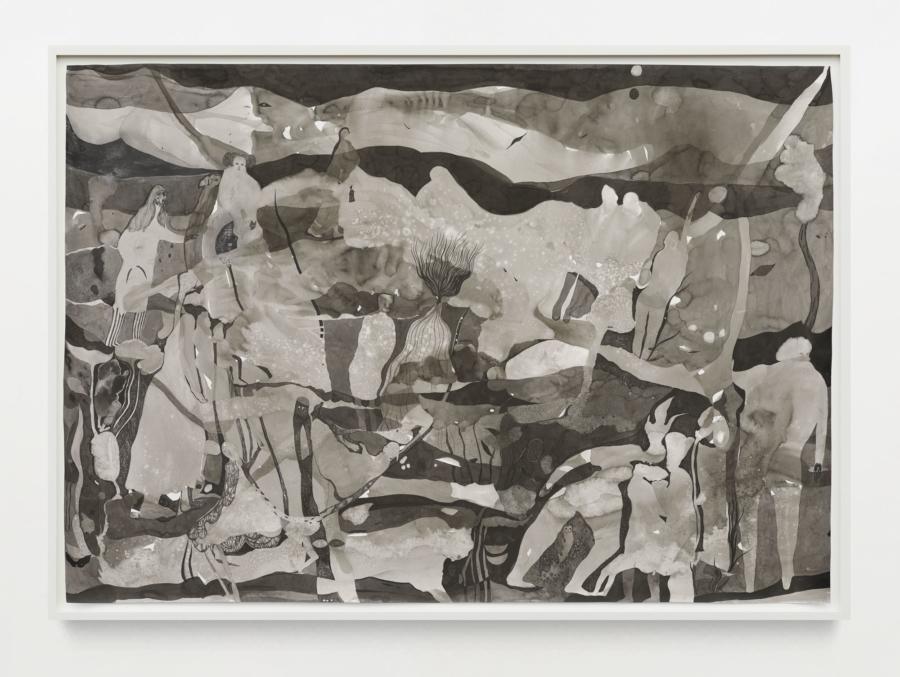
Maja Ruznic
Soil Cleaners 3, 2020
Ink and graphite on paper
42 × 60⅛ inches; 106.7 × 152.7 cm
44½ × 62⅝ inches; 113 × 159.1 cm (framed)
MR-20-012
Maja Ruznic
Soil Cleaners 3, 2020
Ink and graphite on paper
42 × 60⅛ inches; 106.7 × 152.7 cm
44½ × 62⅝ inches; 113 × 159.1 cm (framed)
MR-20-012
Soil Cleaners 6, 2020 (detail)
Soil Cleaners 6, 2020 (detail)
Soil Cleaners 6, 2020 (detail)
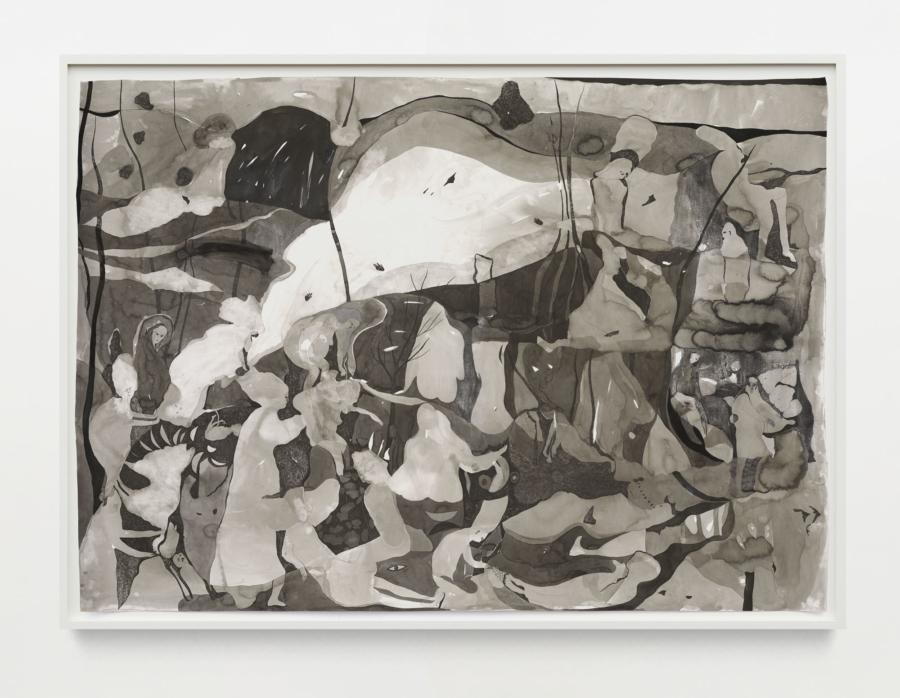
Maja Ruznic
Soil Cleaners 6, 2020
Ink and graphite on paper
42 × 58¾ inches; 106.7 × 149.2 cm
44½ × 61¼ inches; 113 × 155.6 cm (framed)
MR-20-013
Maja Ruznic
Soil Cleaners 6, 2020
Ink and graphite on paper
42 × 58¾ inches; 106.7 × 149.2 cm
44½ × 61¼ inches; 113 × 155.6 cm (framed)
MR-20-013
Sleep Seekers 2, 2020 (detail)
Sleep Seekers 2, 2020 (detail)
Sleep Seekers 2, 2020 (detail)
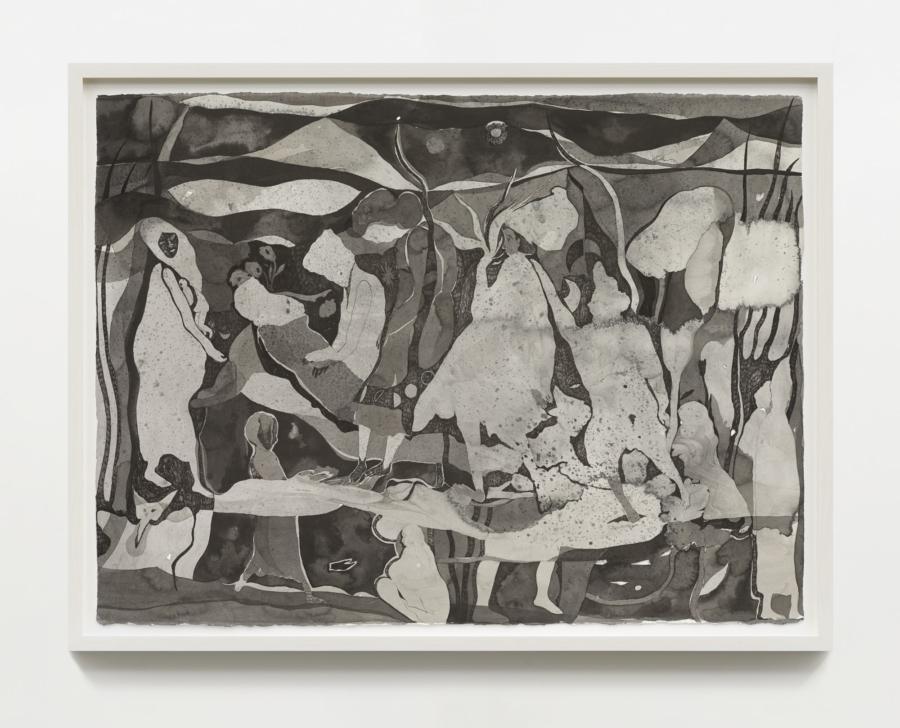
Maja Ruznic
Sleep Seekers 2, 2020
Ink and graphite on paper
22½ × 38 inches; 57.2 × 96.5 cm
29 × 44½ inches; 73.7 × 113 cm (framed)
MR-20-014
Maja Ruznic
Sleep Seekers 2, 2020
Ink and graphite on paper
22½ × 38 inches; 57.2 × 96.5 cm
29 × 44½ inches; 73.7 × 113 cm (framed)
MR-20-014
Sleep Seekers 3, 2020 (detail)
Sleep Seekers 3, 2020 (detail)
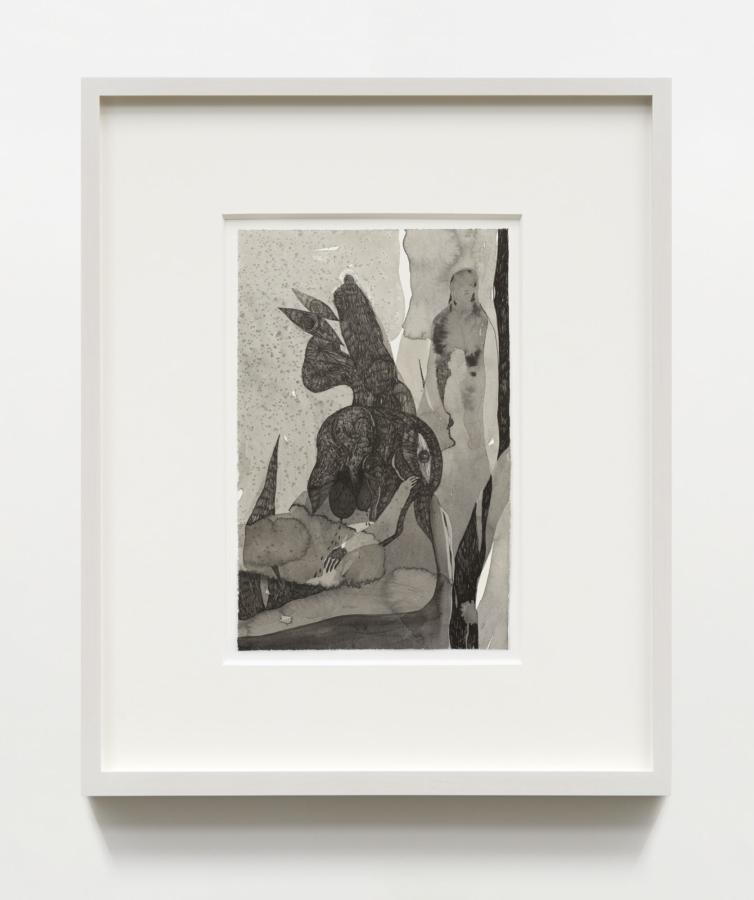
Maja Ruznic
Sleep Seekers 3, 2020
Ink and graphite on paper
14⅜ × 9¼ inches; 36.5 × 23.5 cm
20⅞ × 15¾ inches; 53 × 40 cm (framed)
MR-20-018
Maja Ruznic
Sleep Seekers 3, 2020
Ink and graphite on paper
14⅜ × 9¼ inches; 36.5 × 23.5 cm
20⅞ × 15¾ inches; 53 × 40 cm (framed)
MR-20-018
Sleep Seekers 4, 2020 (detail)
Sleep Seekers 4, 2020 (detail)
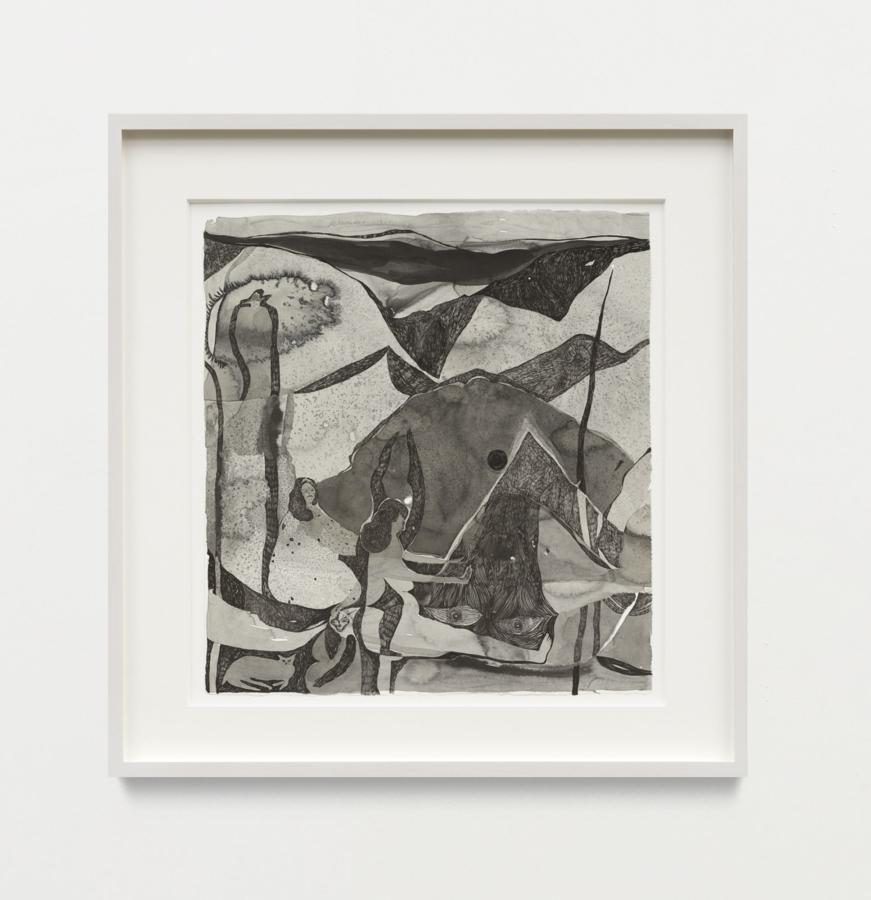
Maja Ruznic
Sleep Seekers 4, 2020
Ink and graphite on paper
22½ × 20¾ inches; 57.2 × 52.7 cm
29 × 27¼ inches; 73.7 × 69.2 cm (framed)
MR-20-019
Maja Ruznic
Sleep Seekers 4, 2020
Ink and graphite on paper
22½ × 20¾ inches; 57.2 × 52.7 cm
29 × 27¼ inches; 73.7 × 69.2 cm (framed)
MR-20-019
Sleep Seekers 5, 2020 (detail)
Sleep Seekers 5, 2020 (detail)
Sleep Seekers 5, 2020 (detail)
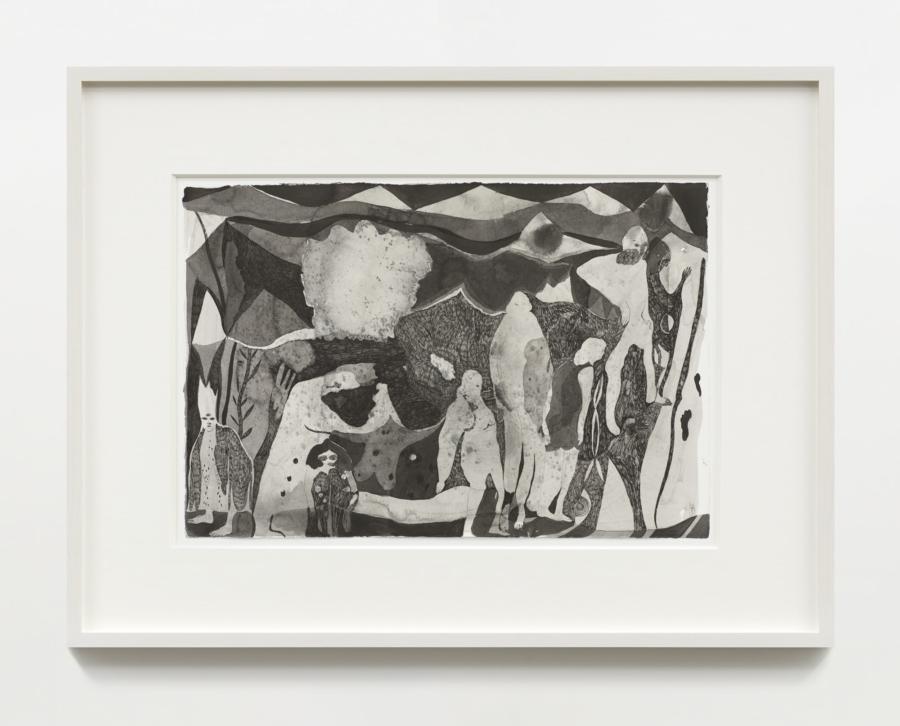
Maja Ruznic
Sleep Seekers 5, 2020
Ink and graphite on paper
15¼ × 22½ inches; 38.7 × 57.2 cm
21½ × 29 inches; 54.6 × 73.7 cm (framed)
MR-20-021
Maja Ruznic
Sleep Seekers 5, 2020
Ink and graphite on paper
15¼ × 22½ inches; 38.7 × 57.2 cm
21½ × 29 inches; 54.6 × 73.7 cm (framed)
MR-20-021
Sleep Seekers 7, 2020 (detail)
Sleep Seekers 7, 2020 (detail)

Maja Ruznic
Sleep Seekers 7, 2020
Ink and graphite on paper
12 × 15 inches; 30.5 × 38.1 cm
17¾ × 21½ inches; 45.2 × 54.6 cm (framed)
MR-20-020
Maja Ruznic
Sleep Seekers 7, 2020
Ink and graphite on paper
12 × 15 inches; 30.5 × 38.1 cm
17¾ × 21½ inches; 45.2 × 54.6 cm (framed)
MR-20-020
Sleep Seekers 8. 2020 (detail)
Sleep Seekers 8, 2020 (detail)
Sleep Seekers 8, 2020 (detail)
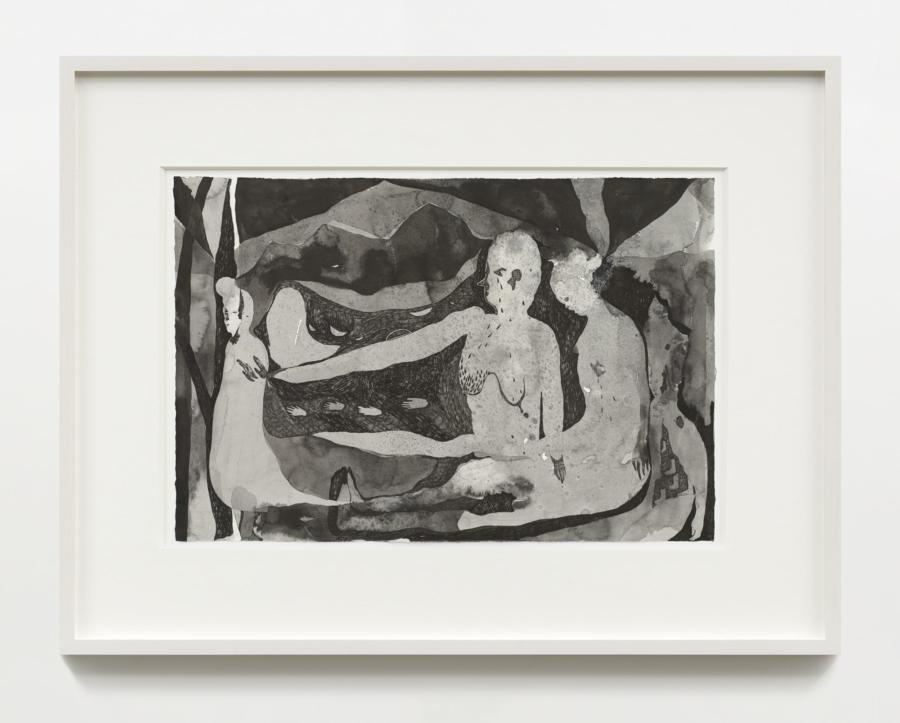
Maja Ruznic
Sleep Seekers 8, 2020
Ink and graphite on paper
15 × 22¼ inches; 38.1 × 56.5 cm
21½ × 28¾ inches; 54.6 × 73 cm (framed)
MR-20-015
Maja Ruznic
Sleep Seekers 8, 2020
Ink and graphite on paper
15 × 22¼ inches; 38.1 × 56.5 cm
21½ × 28¾ inches; 54.6 × 73 cm (framed)
MR-20-015
Sleep Seekers 9, 2020 (detail)
Sleep Seekers 9, 2020 (detail)
Sleep Seekers 9, 2020 (detail)
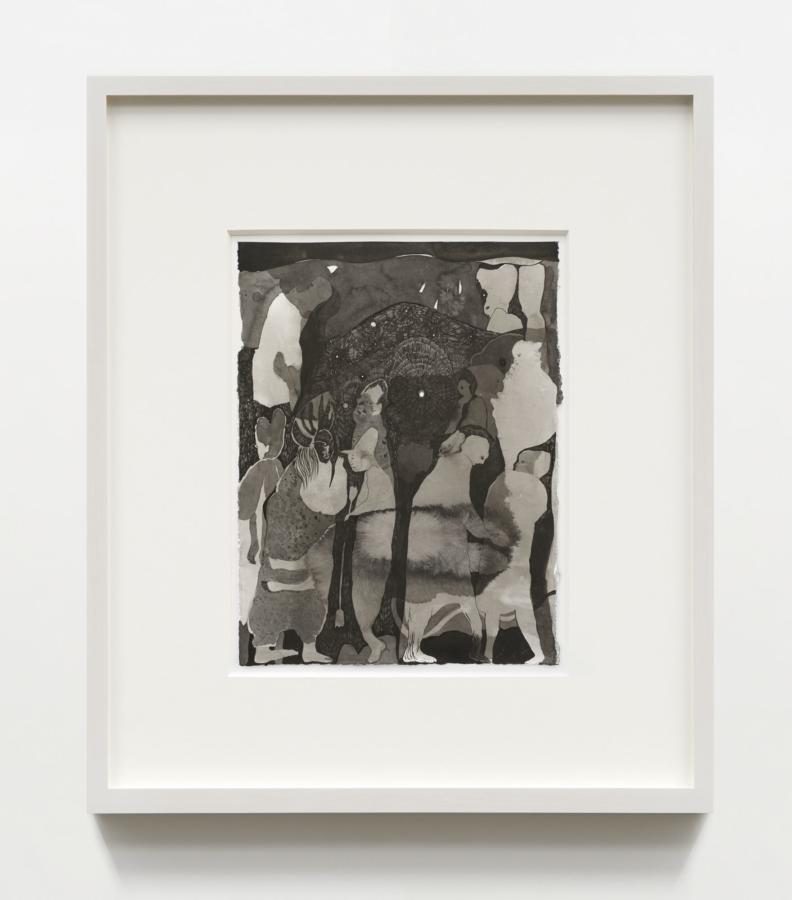
Maja Ruznic
Sleep Seekers 9, 2020
Ink and graphite on paper
12¼ × 9¼ inches; 31.1 × 23.5 cm
18¾ × 15¾ inches; 47.6 × 40 cm (framed)
MR-20-016
Maja Ruznic
Sleep Seekers 9, 2020
Ink and graphite on paper
12¼ × 9¼ inches; 31.1 × 23.5 cm
18¾ × 15¾ inches; 47.6 × 40 cm (framed)
MR-20-016
